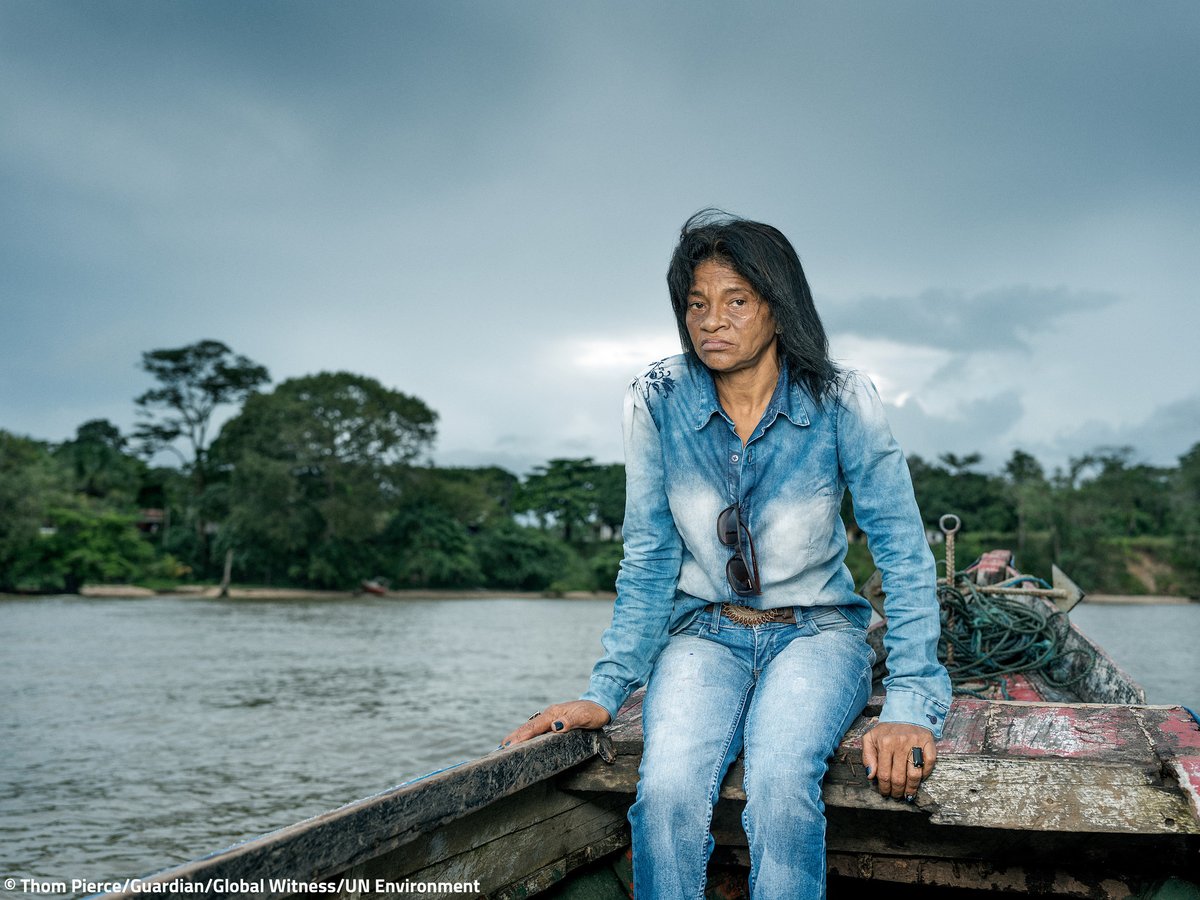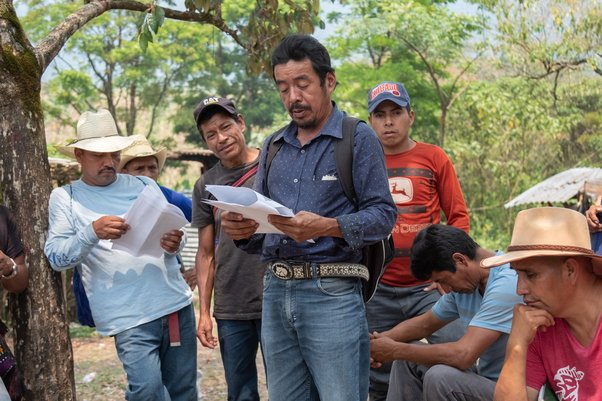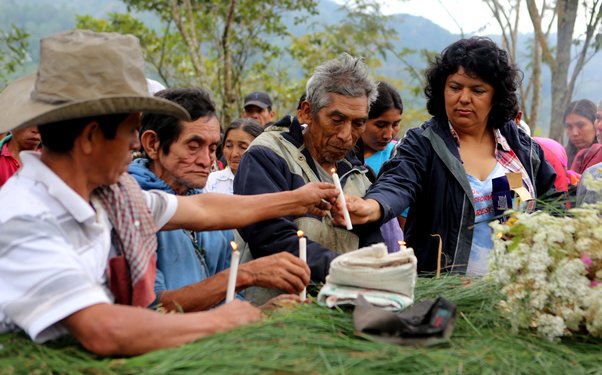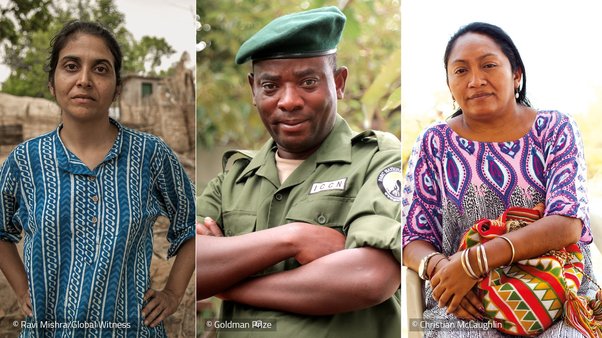Introduction
It has never been a deadlier time to defend one’s community, way of life, or environment
Our latest annual data into violence against land and environmental defenders shows a rise in the number of women and men killed last year to 207 – the highest total we have ever recorded.
What’s more, our research has highlighted agribusiness, including coffee, palm oil and banana plantations, as the industry most associated with these attacks.
Of course my life is at risk, I receive death threats 24 hours a day because I'm not going to shut my mouth in the face of this atrocity
Hernán Bedoya, from Colombia, was shot by a paramilitary group 14 times for protesting against palm oil and banana plantations that were expanding over his community’s territory and clearing the forest.
In the Philippines, after protesting the expansion of a coffee plantation, a community near Lake Sebu was attacked by military forces, leaving eight dead, five wounded, and forcing 200 to flee.
And in Brazil, farmers assaulted the indigenous Gamela community after they attempted to protect their land from logging, severely injuring 22, including children.
But it’s not just defenders in these countries who are being threatened, attacked or killed for fighting to protect their land and way of life.
Countless people around the world are under threat for standing up to the might of large corporations, paramilitary groups and even their own governments.
The data we have painstakingly gathered and presented in this report and the case studies included are almost certainly a sizeable underestimate, given the many challenges in identifying and reporting killings.
Yet even as it stands, it shows that the risks defenders face every day continue to grow, and governments and business have a very serious case to answer.
The global movement
Of the 207 defenders murdered last year, a vast majority of them hailed from Latin America, which remains the most dangerous region for defenders, accounting for 60% of those killed in 2017.
Brazil saw 57 murders alone – the worst year on record anywhere in the world.
But not a single region was immune to the growing number of attacks on its defenders.
The Philippines saw 48 defenders killed, the highest number ever in an Asian country.
And in Africa, 19 defenders were reported killed, 12 of whom were in the Democratic Republic of Congo.
These defenders are part of a global movement to protect the planet.
They are on the frontline of fighting climate change, preserving ecosystems and safeguarding human rights.
They stand up for causes that benefit us all: sustainability, biodiversity and justice.
Irresponsible business driving attacks
The failure of many governments and businesses to act responsibly, ethically and even legally was a major driving force behind a litany of crimes against activists last year.
Companies have a responsibility to their customers, who should have confidence that the products they buy are not fuelling human rights abuses, cultural destruction or environmental devastation.
And consumers have a responsibility to demand that these companies live up to their responsibilities.
When rich tropical forest is levelled for monoculture crops, delicate ecosystems that could capture carbon emissions are lost forever.
When open land is turned over for mining, soil and freshwater are poisoned, jeopardising the health and the future of nearby communities.
It is irresponsible business and investors – hellbent on meeting consumer demand and maximising profit – who, together with corrupt or negligent governments, make this all possible.
Our call to you
We urge the powerful institutions and organisations that threaten the interests of defenders to use their power to be a force for good.
Governments and business have the financial, legislative and executive muscle – as well as the legal duty – to make a profound difference, rather than continuing to be part of the problem.
Despite the odds they face, the global community of land and environmental defenders is not going to go away – it’s only getting stronger.
We will campaign alongside them, taking their fight to the corridors of power and the boardrooms of corporations. We will make sure their voices are heard. And we will be watching to help ensure that they, their land and the environment we all depend on are properly protected.
Global picture
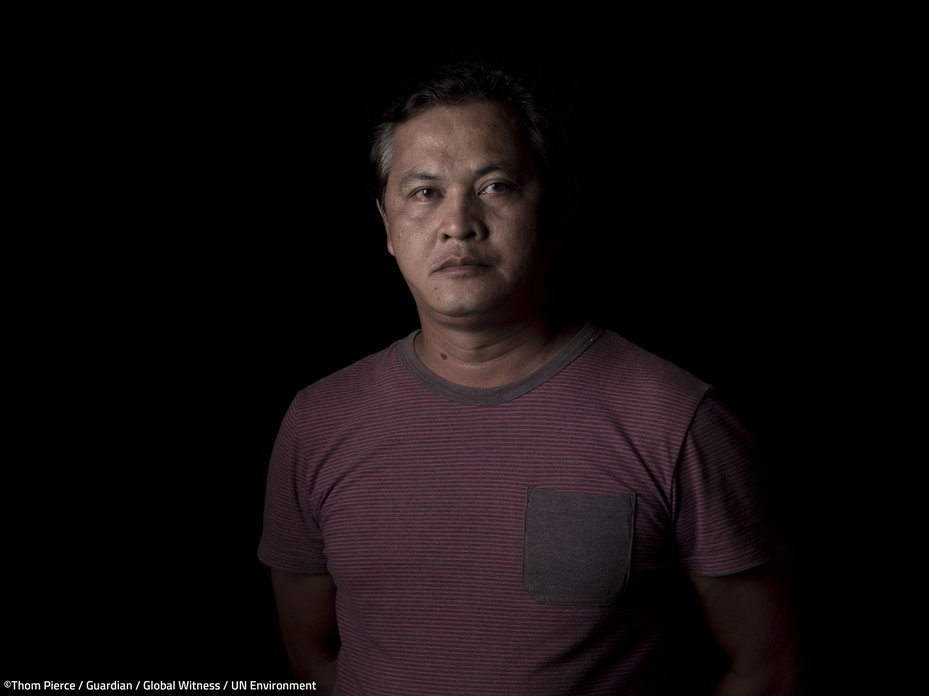
Rene Pamplona has worked tirelessly alongside Indigenous communities like the Taboli-manubo people of Mindanao, who oppose the expansion of a coffee plantation on their ancestral lands. Thom Pierce / Guardian / Global Witness / UN Environment
From The Philippines to Brazil, 2017 was the deadliest year on record for land and environmental defenders.
In 2017, Global Witness documented 207 killings of land and environmental defenders – ordinary people murdered for defending their forests, rivers and homes against destructive industries.
This is six more murders than in 2016, making it the worst year on record.
As the killing has increased, some governments, businesses and intergovernmental organisations have begun to acknowledge the gravity of the situation. But their promises and rhetoric have yet to translate into convincing policies and concrete change, leaving defenders in fear of their lives.
The rise of agribusiness killings
This is, in part, driven by one deadly trend: the number of people killed while protesting against large-scale agriculture more than doubled compared to 2016.
For the first time, agribusiness surpassed mining as the most dangerous sector to oppose, as 46 defenders who protested against palm oil, coffee, tropical fruit and sugar cane plantations, as well as cattle ranching, were murdered in 2017.
Opposition to mining and oil operations (40 killings), poaching (23 murders) and logging (23 cases) were the other main reasons defenders were killed last year.
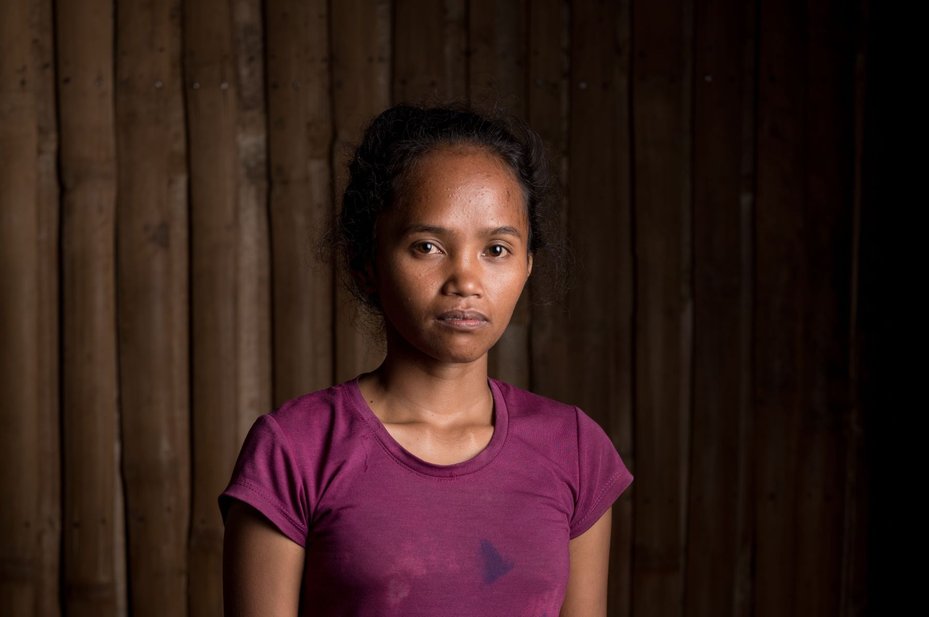
Marivic "Tarsila" Danyan is the eldest child of Datu Victor and wife of Pato Ceralbo, both of whom were killed December 2017. Datu Victor was the lead opponent of a coffee plantation encroaching on their Indigenous community’s land near Lake Sebu. Thom Pierce / Guardian / Global Witness / UN Environment
A year of massacres
Linked to the spike in agribusiness-related deaths, Global Witness observed a rise in multiple killings (seven incidents in total) of land and environmental defenders, many of whom were disputing large-scale agriculture projects.
Brazil was the scene of three horrific massacres, during which 25 defenders died. Eight Indigenous activists were massacred in the Philippines, while Mexico, Peru and the Democratic Republic of Congo also saw incidents where more than four defenders died at the same time.
These massacres sent the message that not only community leaders will be targeted – nobody is safe. This has a huge impact, given that whole communities – or large parts of them – are often involved in struggles to protect their land from being grabbed.
The death toll: Region by region
Once again, Latin America saw the highest number of murders, accounting for almost 60% of the total. According to Global Witness data, Brazil recorded the most killings of any country ever with 57 people killed, 80% of them while protecting the natural riches of the Amazon.
In Colombia 24 defenders were murdered in 2017, as conflicts over land raged on.
Mexico and Peru saw a jump in killings from three to 15 and two to eight respectively.
There were fewer murders in Honduras – five compared to 14 in 2016 – but the growing repression of civil society has restricted what defenders can say and do.
Nicaragua registered the most murders per capita, with four defenders killed.
In Asia, the most alarming developments took place in the Philippines, which saw 48 killings – almost a 71% rise on 2016 and the most murders ever recorded in Asia in a single year.
President Duterte’s aggressively anti-human-rights stance and a renewed military presence in resource-rich regions are fuelling the violence. Almost half of the killings in the Philippines were linked to struggles against agribusiness.
Of the 19 land and environmental defenders reported killed across Africa, 17 lost their lives while defending protected areas against poachers and illegal miners – 12 in the Democratic Republic of Congo alone.
Of course, many other countries and regions could be suffering elevated numbers of killings which have not been documented or which we have been unable to verify.

Datu Dande Dinyan is a member of the Taboli-manubo Sdaf Claimants Organisation (TAMASCO) protesting against the expansion of the Silvicultural industries coffee plantation in Mindanao, the Philippines.. Thom Pierce / Guardian / Global Witness / UN Environment
Specific threats to Indigenous groups and women
Fewer Indigenous people were killed in 2017 – falling to 25% of the total from 40% in 2016. However, with Indigenous groups making up just 5% of the world’s population, they remain massively overrepresented among defenders killed.
And it is not only killings. In one of the most brutal attacks, Gamela Indigenous people were assaulted with machetes and rifles by Brazilian farmers, leaving 22 of them severely injured, some with their hands cut off. In Mexico, 13 out of 15 defenders killed were Indigenous – murdered defending their ancestral territories.
Although nine out of every 10 murdered activists last year were male, women defenders faced gender-specific threats including sexual violence. They were often subjected to smear-campaigns, threats against their children, and attempts to undermine their credibility – sometimes from within their own communities, where macho cultures might prevent women from taking up positions of leadership.
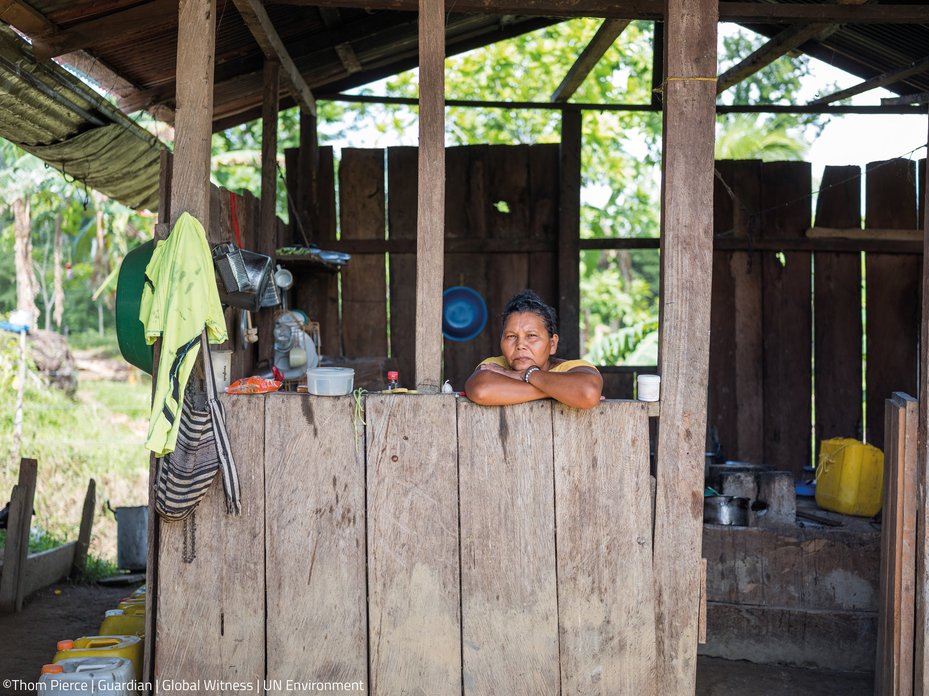
There is a business incentive for companies, investors and bilateral aid and trade partners to work more closely with local communities, respect their rights and take action alongside national governments to protect defenders. Thom Pierce / Guardian / Global Witness / UN Environment
The tip of the iceberg
Our data on killings is likely to be an underestimate, given that many murders go unreported, particularly in rural areas.
Our methodology requires cases to be verified according to a strict set of criteria (see Methodology on page 52 of full report), which can’t always be met by a review of public information like newspaper reports or legal documents, nor through local contacts.
Having a strict methodology means our figures don’t represent the scale of the problem, and we are working to improve this.
In some countries, suppression of the media, a lack of monitoring and documentation by both governments and NGOs, or the fact that information emerging from conflict zones can often be unclear or contradictory can make it difficult to identify specific cases.
These challenges in reporting, coupled with shrinking space for free speech and civic organisation in many places, means it is highly likely many more defenders are killed than we have documented.
It is also important to note that a low number of documented murders in a given country does not necessarily mean that defenders there are not facing other threats such as imprisonment or harassment (see "Africa" section).
Our data may differ from that being gathered by other NGOs, and there are three likely reasons for this.
Firstly, different groups are being monitored. Some NGOs document attacks against all human rights defenders. Global Witness data only covers one subgroup of defenders: those working on land or environmental issues.
Secondly, some NGOs document all threats, attacks and restrictions on defenders. We only document killings.
Thirdly, it may be the case that different NGOs are using different methodologies to verify and include cases in their statistics.
Their faces: Defenders on the frontline
Meet the brave men and women standing up for their land and our environment in the face of violence and threats.
The food on our plates, the rings on our fingers and the wooden furniture in our homes – all too often there is a violent reality behind household items we use everyday.
As agribusiness booms, tropical forests are logged and mining continues to deliver huge revenue to major global corporations, there are increasingly brutal attacks on land and environmental defenders – the men and women who dare to oppose unscrupulous governments, companies and investors profiting from their land, in what is a grossly unequal struggle.
In Colombia, Hernán Bedoya was shot by a paramilitary group 14 times. He was killed after protesting against palm oil and banana plantations on land stolen from his community.
In the Philippines, near the town of Lake Sebu, the military descended on a small community, leaving eight dead, wounding five and causing 200 to flee.
And in one of the largest scale attacks of 2017, Gamela Indigenous people were assaulted in Brazil. Powerful ranchers used machetes and rifles in an attempt to forcibly seize control of their land, leaving 22 severely injured, some with their hands cut off.
Every defender has his or her own story, some of which we tell here, but they are all part of a global movement to protect the planet.
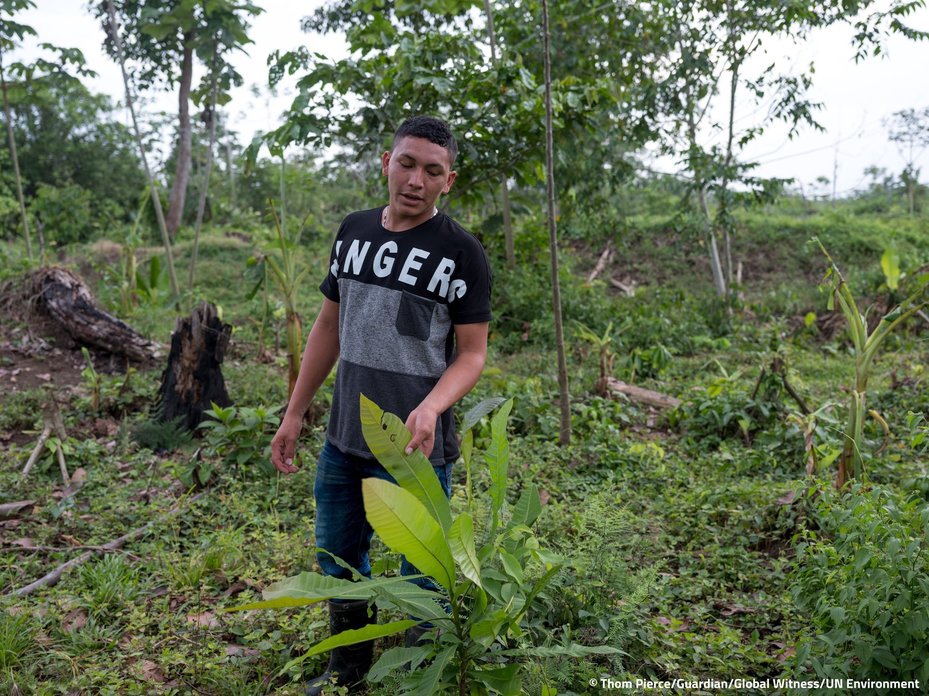
Ramón Bedoya’s father was killed after protesting against palm oil and banana plantations on land stolen from his community, which are threatening the area’s biodiversity. Thom Pierce / Guardian / Global Witness / UN Environment
They are on the frontline of fighting climate change, preserving ecosystems and safeguarding human rights. They stand up for causes that benefit us all: sustainability, biodiversity and justice.
And we stand with them.
Below we introduce you to some of these brave men and women standing up for their land, forests and rivers, explore the industries behind the violence, and explain how you can stand with them to end the killings.
The Philippines
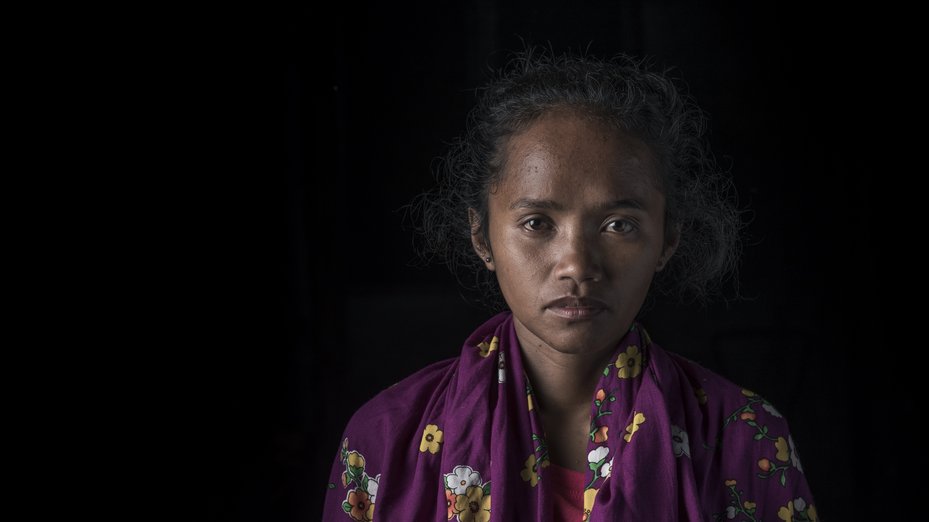
Marivic "Tarsila" Danyan, from Lake Sebu, Philippines. The Ta’boli–Manobo people of Mindanao are opposing the imposition of a coffee plantation on their ancestral lands. Thom Pierce / Guardian / Global Witness / UN Environment
For the Ta’boli–Manobo people of Mindanao, the Silvicultural Industries coffee plantation had only brought "poverty", "hardship" and a "violation of [their] human rights."
When plans were put forward to extend a plantation already covering 300 hectares of their ancestral land, the community were consulted and said “no.” Little wonder, then, they continue to oppose the expansion.
"We hope," they said, "that the government and the company […] will respect our decision."
However, according to Rene Pamplona, a defender working closely with the Taboli-manubo Sdaf Claimants Organization (TAMASCO), which is protesting against the expansion, their members were harassed and intimidated by Silvicultural Industries employees and by armed groups after opposing the renewal of the land’s lease to the company.
A year after the company’s contract expired, rumours continued that the company had indeed been granted a new contract, and the plantation would nonetheless be expanded.
Then, on 3 December 2017, the Filipino military launched an attack near the town of Lake Sebu.
At least eight members of the community were killed as a result. A fact-finding mission found that five more were wounded, 10 were missing and more than 200 had to evacuate the area.
When I got there, the place was covered in empty bullet shells, and it made me think: all these Indigenous people ever wanted was to be able to reclaim their ancestral lands and live in peace
Military expulsion, agricultural expansion
The massacre is emblematic of the growing threat agribusiness and the military pose to land and environmental defenders in the Philippines. The eight people who died at Lake Sebu were among 48 defenders from across the country who were killed in 2017 – the highest number ever recorded there.
Twenty of these murders were linked to struggles against agribusiness, and civil society reports suggest the military were involved in many of them.
The military expulsion of small-scale farmers and Indigenous people from their land to make way for large-scale agriculture is nothing new in the Philippines. According to one study, the imposition of martial law by President Ferdinand Marcos was a catalyst for the mass acquisition of land for oil palm plantations between 1972 and 1981.
Communities were displaced or felt compelled to sell their land to companies for a pittance to escape military incursions and the atrocities that tended to follow.
History is in danger of repeating itself. In 2017, President Duterte’s administration announced that it aims to allocate 1.6 million hectares of land for industrial plantations. Most of this expansion is earmarked for the island of Mindanao, where 67% of the murders of land and environmental defenders have taken place.
In May 2017, Duterte declared martial law in Mindanao, after clashes involving government forces, Islamic extremists and armed left-wing rebels. But the imposition of martial law has seen the military attack and bomb Indigenous people’s territories, and force them from their land – most notably at Lake Sebu.
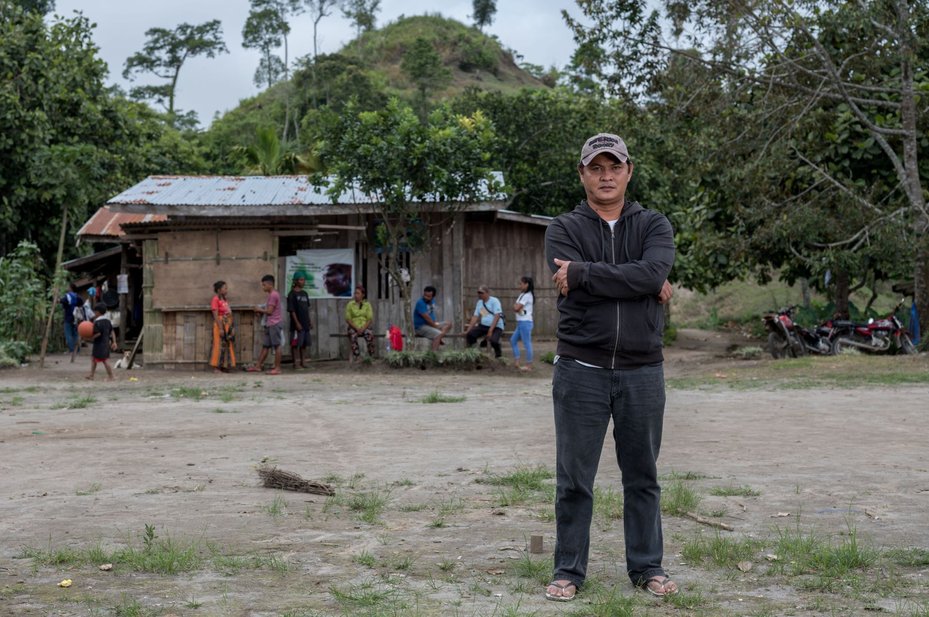
Against a backdrop of violence, Rene Pamplona has worked tirelessly alongside Indigenous communities like the Taboli-manubo people of Mindanao, who oppose the expansion of a coffee plantation on their ancestral lands. Thom Pierce / Guardian / Global Witness / UN Environment
Lake Sebu: Reasons to be suspicious
The army claims the Lake Sebu attack was an act of retaliation, alleging rebels from the New People’s Army (NPA) – the armed wing of the Philippines Communist Party – opened fire on soldiers patrolling the area.
But no members of the communist group were found among the dead. Instead, Datu Victor Danyan, one of the main opponents of the coffee plantation’s expansion, and four members of his family, were killed.
It is still not clear why Datu Victor and his family were murdered. However, anonymous sources close to the issue told Global Witness that members of the Special Civilian Armed Auxiliary (SCAA), an auxiliary army unit that provides security services to Silvicultural Industries, may have been involved.
A number of SCAA groups across the Philippines stand accused of multiple human rights abuses against communities who oppose mining and other extractive projects.
One of the sources speculated that the SCAA might have falsely informed the army that the NPA were present among the community, so as to incite violence against those opposed to the plantation.
Another source speculated that the SCAA might be trying to make an example of TAMASCO to dissuade others from following its lead, especially after the community organisation’s decision to reject the lease renewal inspired other communities who oppose the coffee plantation.
While the army acted consistently to support the interests of Silvicultural Industries in the land, there is no hard evidence that Silvicultural Industries secured or commissioned military intervention.
Systematic targeting of defenders
Whether or not the SCAA was involved at Lake Sebu, Duterte’s military campaign against the NPA and its sympathisers has allegedly claimed the lives of many innocent civilians, disproportionately affecting Indigenous communities in Mindanao.
Reports by the UN and local organisations say the military have killed human rights defenders in Mindanao.
The army denies the claims and says it only kills NPA rebels, but the sheer number of deaths of community and Indigenous leaders involved in land disputes suggests that the army might be systematically targeting land and environmental defenders.
One thing is certain: the number of defenders killed since Duterte became president has risen dramatically.
The year before he was elected, Global Witness recorded the murder of 30 defenders. The number of killings increased to 44 between July 2016 and June 2017, the first year of Duterte’s administration, while 24 have been murdered in just the first six months of his second year in office.
What is more, a number of those allegedly killed by soldiers had previously received death threats, suggesting their killings were neither random nor accidental.
The president has a zero-tolerance approach to those he sees as obstacles to his agenda. In August 2017, Duterte threatened to kill rights activists who he deemed to be "obstructing justice."
He labelled Victoria Tauli-Corpuz, the UN special rapporteur on the rights of Indigenous peoples, and other rights campaigners "communists" and "terrorists" after they dared to criticise his regime. He threatened to throw other UN experts to the crocodiles.
The president and the army have been brutal in their response to opposition. Duterte has announced, for example, that he will pay a US$500 bounty for each communist rebel killed by his forces. He promised to arm and train Indigenous groups to go after the rebels. He even ordered his soldiers to shoot rebel women "in the vagina."
In this violent context, Indigenous communities and those advocating for land rights or opposing industries like agribusiness are at extreme risk.
If Global Witness can identify this risk, then agribusiness investors should be able to as well, and should avoid doing business in the Philippines, until the government takes genuine steps to address the grievances of affected communities and protect defenders.
To invest in agribusiness currently in Duterte’s Philippines is to invest irresponsibly. It could mean contributing to the murder of countless ordinary people struggling to live in peace off their land.

Eight members of the Taboli-manubo community who opposed the expansion of a coffee plantation were killed in an army attack in 2017. Thom Pierce / Guardian / Global Witness / UN Environment
Unholy alliance: Agribusiness and the military in the Philippines
- At least 48 land and environmental defenders murdered in 2017 – almost a 71% rise on 2016 and the most murders ever recorded in Asia in a single year.
- The widespread criminalisation and demonisation of human rights defenders saw one UN expert labelled a terrorist and the president threaten to throw others to the crocodiles.
- Suspected army involvement in 56% of the murders. 67% of killings occurred in the resource-rich island of Mindanao, and 41% were related to agribusiness.
Recommendations to the government of the Philippines
- Tackle root causes. Strengthen institutions for the protection of Indigenous and land rights, including by reforming and fully resourcing the NCIP (National Commission on Indigenous Peoples) and by broadening the mandate and strengthening the accountability of the Indigenous peoples’ inter-agency task force.
- Support and protect. Pass and implement a law for the recognition and protection of human rights defenders, incorporating civil society input.
- Ensure accountability. Guarantee that all military personnel, and any armed groups working on behalf of the state or private interests that are accused of extra-judicial killings of civilians, are tried by civilian tribunals.
Mexico
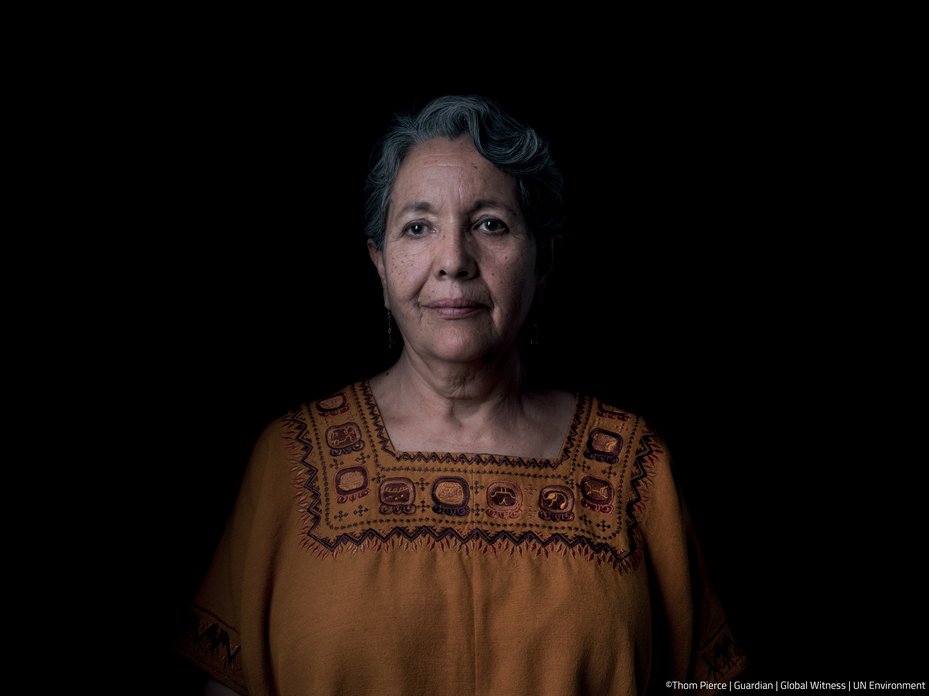
Isela González from Creel, Mexico. The Sierra Madre community are speaking out against logging on their land in the face of threats and a lack of government protection. Thom Pierce / Guardian / Global Witness / UN Environment
Isidro Baldenegro knew his life was at risk.
He defended the forests of the Sierra Tarahumara mountain range from a powerful alliance of local strongmen, drug traffickers and loggers – work which saw him win the 2005 Goldman Environment Prize, a global award for activism.
After receiving threats he left his community in northern Mexico. But when Isidro returned on 15 January 2017, he was shot and killed by a suspected hitman.
History had tragically repeated itself: Isidro’s father was also brutally murdered 30 years earlier, also for opposing logging.
Isidro was a victim of the steep rise in violence against environmental and land defenders in Mexico last year. Global Witness reported three killings in 2016, yet in 2017 that number increased to 15.
Like Isidro, the vast majority of these defenders were Indigenous people fighting to hold onto their ancestral land in the face of individuals, criminal groups and companies wanting to control land and exploit natural resources.
Some of the reasons for this escalation of violence can be found in Isidro’s case – the spread of organised crime, persistent impunity, the government’s failure to provide protection and (crucially) the lack of free, prior and informed consent (see Annex II) from communities for the use of their land or the exploitation of their natural resources.
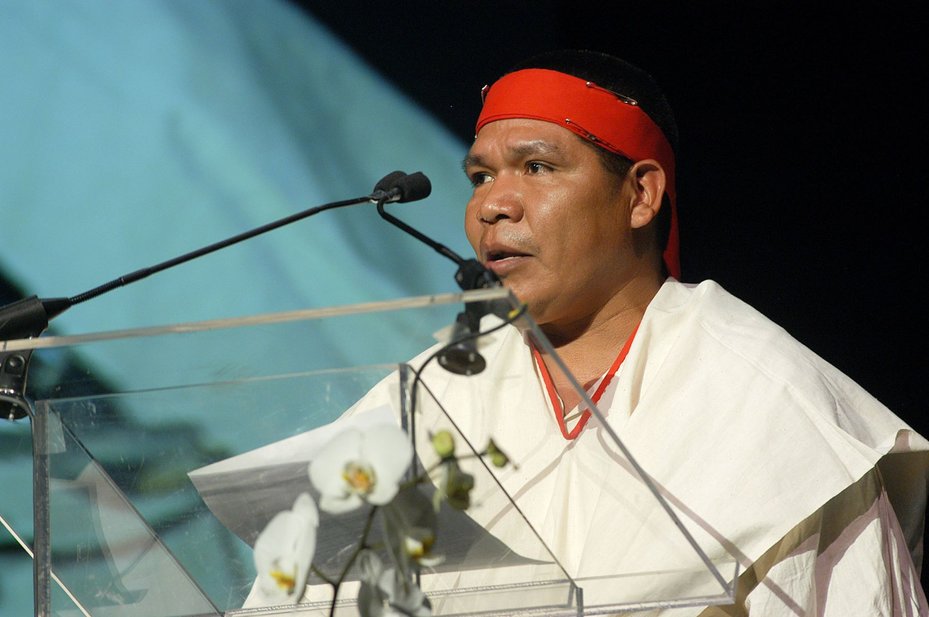
Isidro Baldenegro won the 2015 Goldman Prize for his activism defending the forests of the Sierra Tarahumara mountain range. He was shot dead on 15 January 2017.. Thom Pierce / Guardian / Global Witness / UN Environment
They have to leave their territory because of a government decision to grant mining concessions or to exploit the forests, or because of a “de facto” occupation by drug traffickers
The rise of organised crime
The Sierra Tarahumara, a mountainous area near the US border, has been home to Indigenous people for centuries.
But over the last few decades, their ancestral lands have been threatened by the arrival of infrastructure and extractive projects, logging concessions and a surge in organised crime cultivating and transporting illicit substances. Indigenous communities have been forced to abandon their lands.
The increase in killings of Mexican defenders has coincided with a massive rise in murders stemming from organised crime. In 2017, criminal groups were allegedly responsible for almost 19,000 executions – making it the worst year on record.
CEMDA, an organisation that supports environmental defenders in Mexico, observed that violence against land and environmental defenders was getting worse in areas where organised crime had a strong presence. It found that organised crime was responsible for several attacks on defenders.
The rise of organised crime both intensifies conflict over land – which cartels require for drug trafficking and other criminal activities – and provides loggers, drug traffickers and other criminal groups with hitmen they can employ to secure their interests, including by threatening and attacking defenders.
Impunity: Zero consequences for crime
An astonishing 98% of all crimes in Mexico are never solved. Isidro Baldenegro was a high-profile prizewinning defender who the state knew was at risk, but this did not deter his murderers, who must have known they would almost certainly never face justice.
During a visit to Mexico in January 2017, the UN Special Rapporteur on the situation of human rights defenders said: "The failure to investigate and sanction perpetrators [of crimes against human rights defenders] sends a dangerous message that such crimes have zero consequences, creating an environment conducive to serial violations."
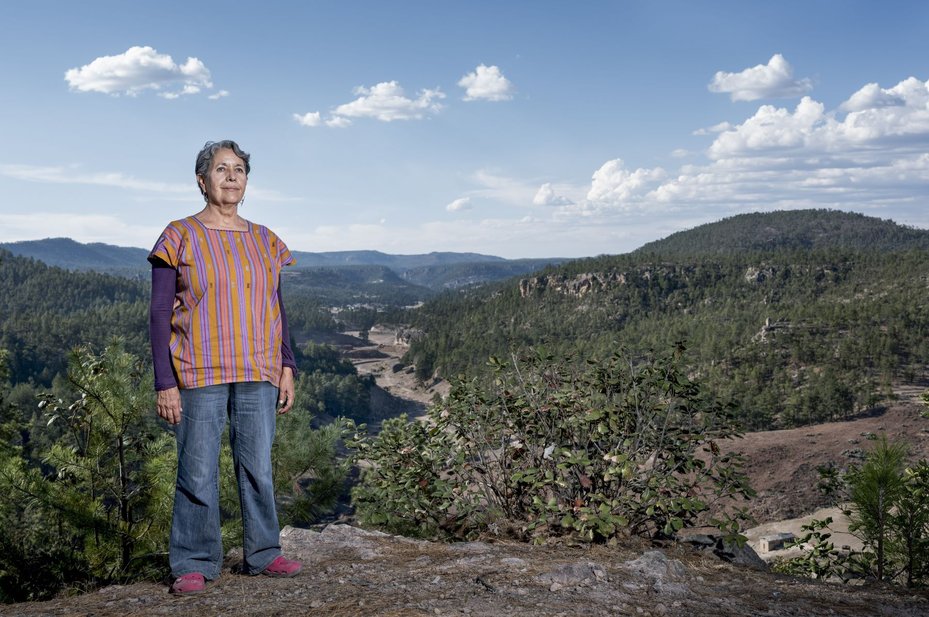
With the perpetrators of attacks on defenders rarely punished in Mexico, activists like Isela González, the Chairperson of Alianza Sierra Madre, find their work restricted by the threat of attacks. Thom Pierce / Guardian / Global Witness / UN Environment
Government "protection" that doesn’t protect
The communities of Coloradas de la Virgen and Choreachi in Sierra Tarahumara were involved in a long-running legal dispute against the granting of logging concessions on their ancestral land.
According to Isela González, head of the Sierra Madre Alliance – a local organisation which defends indigenous rights – seven members of these two communities were killed between 2013 and 2016. None of the murderers have been brought to justice.
After these attacks, the Mexican government was instructed by the Inter-American Human Rights system to work with these communities to define and implement measures for their protection. However, the effectiveness of these measures, which have never been properly implemented, is questionable.
Community members still receive threats and don’t trust the government to protect them.
One community leader was authorised government protection but – following the brutal killing of one of his fellow activists, Juan Ontiveros Ramos, in February 2017 – was so scared that he left his community to hide in a cave.
Eleven days before his assassination, Juan had met with Mexican government representatives to ask for protection for him and his whole community, but it failed to prevent his death.
Isela González herself received death threats in 2014, after her involvement in the legal campaign against logging in Coloradas de la Virgen. She, too, was offered protection by the state, which included measures such as a panic button and the possibility to request police escorts. However, she told Global Witness that she doesn't feel protected.
Mexico is one of the few countries in the world with a specific law and mechanism to protect human rights defenders, but it is not working effectively.
A recent study by a coalition of Mexican NGOs concluded that a comprehensive government policy is needed to complement the existing law – one that fosters a culture of celebrating defenders rather than stigmatising them, that combats impunity, and that guarantees the political will required to tackle the problem.
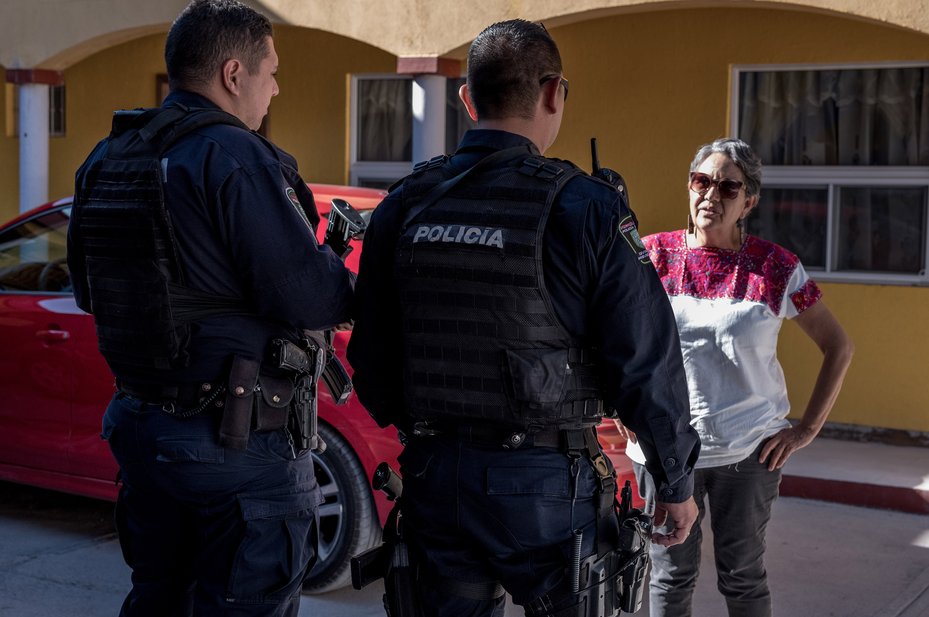
Even when Mexican defenders are granted state protection, implementation is often limited, meaning they are still unable to carry out their work without fear for their lives. Thom Pierce / Guardian / Global Witness / UN Environment
Lack of free, prior and informed consent
The imposition of projects on communities without their free, prior and informed consent is a root cause of the attacks on Mexican defenders. When logging, mining or other projects go ahead before the local community has been consulted, and without their agreement, the seeds of conflict are sown.
Since 2007, the Mexican Environmental Authority has granted logging concessions over 24,000 hectares of Indigenous territory in Coloradas de la Virgen. However, it has failed to consult the affected Indigenous communities as required by international law.
Many Indigenous people have been forced to leave their homes to give way to the loggers. Those who opposed the concessions – through legal action or protests – have been the victims of death threats, attacks and murder. Since 2016, six members of the community have been killed, including Isidro Baldenegro.
Nevertheless, this is not an issue only confined to the Sierra Tarahumara or logging. According to the InterAmerican Commission on Human Rights, in 2013 many of the approximately 2,600 mining concessions in Mexico were operating on ancestral territories without the consent of the Indigenous peoples living there.
In order to end the violence against land and environmental defenders, the Mexican government must tackle the root causes of conflict, and implement its international obligations to guarantee that communities can give or withhold their free, prior and informed consent regarding the use of their land and natural resources.
It also needs to combat impunity, find an effective way to tackle organised crime, and prioritise the implementation of comprehensive policies for the protection of human rights defenders. If not, the killings of activists will continue to intensify.
Rising tide of violence: Organised crime and threatened communities in Mexico
- At least 15 defenders killed in 2017, up from three the previous year. Almost three-quarters were indigenous.
- Organised crime is flourishing in a context of impunity, leading to increased violence against defenders, particularly in areas where drug gangs have a presence.
- Laws on natural resource governance, indigenous rights and the environment, as well as measures to protect defenders, are not being implemented properly by the government.
Recommendations to the government of Mexico
- Tackle root causes. Guarantee meaningful, transparent and informed social, environmental and human rights impact assessments are carried out before any permission or concession for a development project or natural resource exploitation is authorised, ensuring that potentially affected communities can participate in these assessments and that any impacts identified are mitigated in a way which those affected deem adequate.
- Support and protect. Implement the recommendations in the 2018 report "Protección integral para personas defensoras de derechos humanos y periodistas: la deuda del Estado mexicano" by the Civil Society Space coalition on how to strengthen implementation of the Law for the Protection of Journalists and Human Rights Defenders.
- Ensure accountability. Ensure all investigations into crimes against defenders adequately consider potential motives linked to the defender’s human rights activism.
Brazil
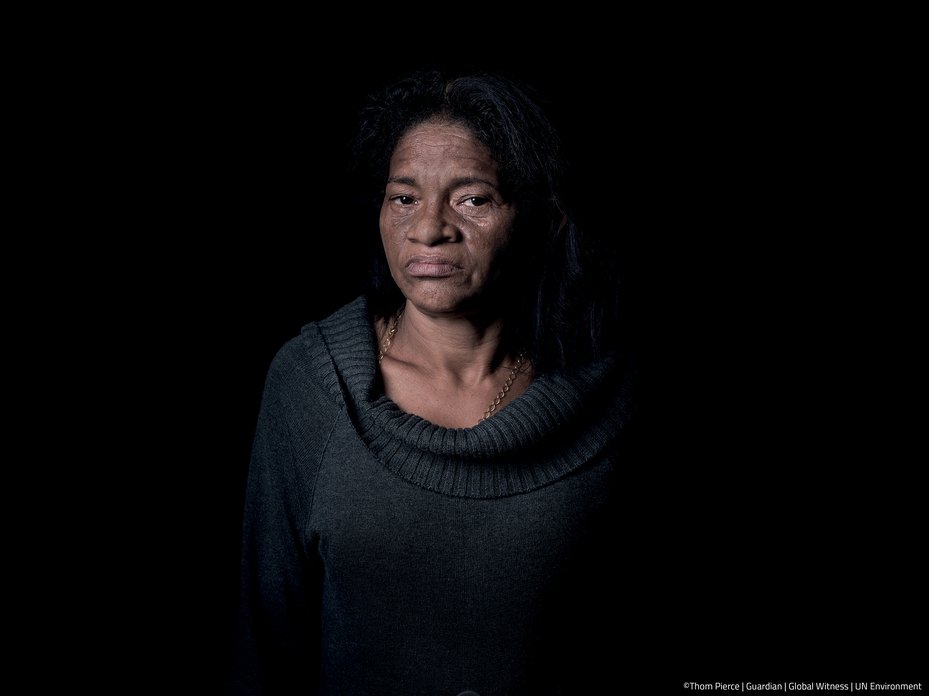
Maria do Socorro Silva from Barcarena, Brazil. Indigenous peoples, Afro-descendents and small-scale farmers are struggling for their land rights in the deadliest country for defenders. Thom Pierce / Guardian / Global Witness / UN Environment
Year after year, in a bitter struggle over land, more environmental and land defenders are killed in Brazil than anywhere else in the world.
Global Witness data shows that in 2017, 57 defenders were murdered, 25 of them during three mass killings.
The year’s first massacre saw hired assassins torture and kill nine villagers in Mato Grosso state on 19 April. A timber exporter, who wanted to log on the villagers’ land, has been charged with ordering the murders to open the way for loggers to gain access to the land.
In a second massacre on 24 May, around 30 police officers opened fire on a group of landless farmers in Pará state, killing 10 of them. The farmers had peacefully occupied the Santa Lucia ranch the day before to demand that their land rights be recognised.
Rather than taking steps to prevent such appalling atrocities against defenders, President Michel Temer has weakened the laws and institutions designed to protect them. He has made it easier than ever for industries like agribusiness – associated with at least 12 murders in Brazil in 2017 according to Global Witness statistics – to impose their projects on communities without their consent.
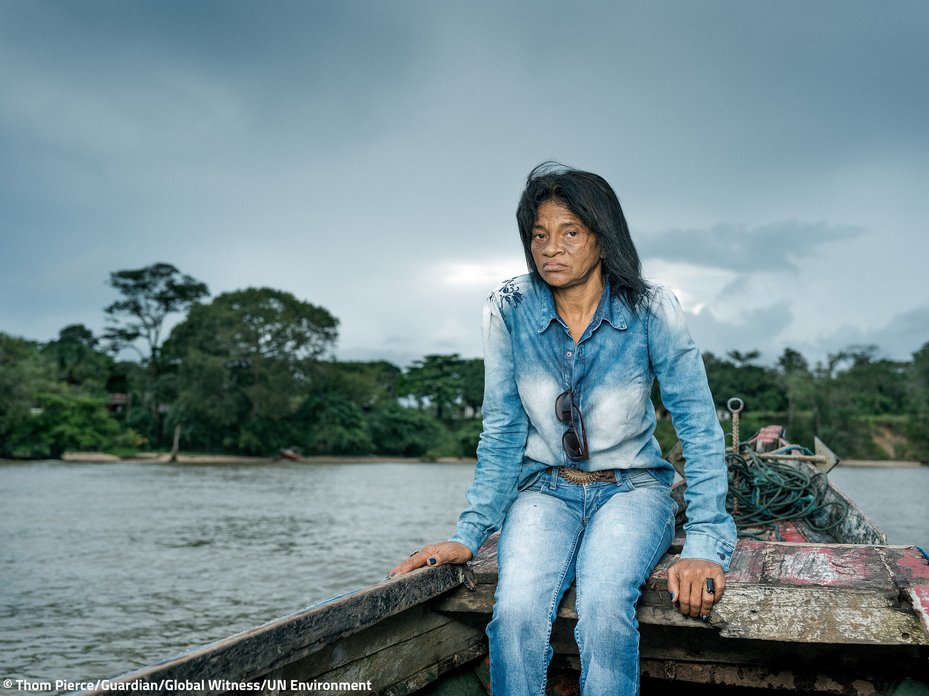
Maria do Socorro Silva campaigns with communities against a Norwegian-owned aluminium plant which is accused of water poisoning in the town of Barcarena, Brazil. Thom Pierce / Guardian / Global Witness / UN Environment
Cutting budgets, undermining rights
Massive budget cuts to key government agencies responsible for protecting human rights and the environment mean defenders are more at risk than ever.
In 2017, INCRA – the state body responsible for redistributing land to small-scale farmers and Afro-descendants – saw its budget slashed by 30%. The budget of FUNAI, the agency responsible for protecting Indigenous peoples’ rights, was almost halved, forcing it to close some of its regional offices.
One such office was in the Indigenous territory of Vale do Javari, where illegal gold miners allegedly massacred 10 members of uncontacted tribes in August 2017. The closure of FUNAI bases on the river in Vale do Javari may have facilitated the miners’ unmonitored access to this remote area, sparking tensions with the uncontacted Indigenous group.
The bodies of the victims were never found, and their names never verified, so we have not added them to our database.
Meanwhile, the National Programme for the Protection of Human Rights Defenders remains underfunded, often limiting the protection it provides to telephone calls from officers based far away in Brazil’s capital, Brasilia.
What’s more, the mechanism that allows serious human rights violations - including killings of land and environmental defenders – to be investigated and tried at the Federal level, instead of at the local level, has been underused.
"Federalisation", as this mechanism is known, allows the Federal Prosecutor’s Office to request a change of jurisdiction when there is evidence that state level institutions are unable to adequately investigate and try a serious human rights violation due to inaction, negligence, lack of political will or scarce human and material resources.
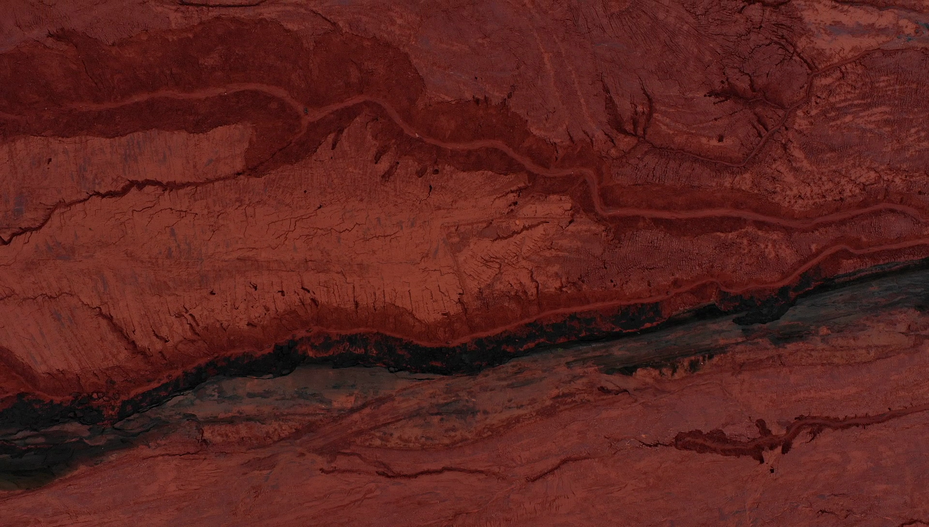
Drone footage of the environmental damage caused to the Amazon rainforest in Brazil by deforestation and pollution from extractive projects.Leo Plunkett
Agribusiness' sabotage of people’s right to land
As well as having their budgets cut, FUNAI and INCRA also had their reputations battered by a congressional commission created to investigate irregularities in land demarcations – the way in which land has been officially allocated to the Indigenous peoples, Afro-descendants and small-scale farmers who already inhabit it.
The commission’s final report accused FUNAI and INCRA officials of backing fraudulent land claims, and requested the indictment of 67 people.
However this appears to be a conscious attempt to undermine the institutions tasked with protecting people’s right to land by a body that is far from impartial. The investigation was initiated by the powerful ruralistas, an agribusiness lobby group that opposes land demarcations.
The ruralistas control more than half of Brazil’s Congress, and have close links to President Temer, helping to keep him in power after his alleged involvement in corruption.
Of course, my life is at risk, I receive death threats 24 hours a day because I'm not going to shut my mouth in the face of this atrocity
A dangerous power imbalance
There is an obvious asymmetry of power between agribusinesses and their political backers on one side and Indigenous peoples, Afro-descendants and small-scale farmers on the other.
There is also a huge amount at stake in this one-sided struggle for land. Almost 90% of defenders killed in 2017 died trying to protect the Amazon – an area which they depend on for their livelihood and which is of crucial significance in capturing carbon emissions and combating global climate change.
This power imbalance will be exacerbated by a series of environmentally regressive laws currently working their way through Congress. The government – which is mired in one of the largest corruption scandals in history – has apparently done nothing to slow these initiatives.
Among them is a draft law designed to help foreign investors buy up huge areas of land, inevitably allowing large-scale agriculture to encroach deeper onto indigenous lands.
Another draft law aims to convert an area of the Amazon three times the size of Hong Kong into a different classification of forest which would allow for future exploitation by large-scale agriculture, mining and logging.
If the Brazilian government continues to favour the interests of big business over those of small-scale farmers and indigenous peoples, then environmental destruction and conflicts over land will increase.
Given that 2017 in Brazil was the deadliest year on record for any country, investors should avoid investing in those sectors associated with murders in the country.
It is also clear that supporting defenders should be an urgent priority for whoever wins this year’s presidential elections. Increased political will, the reversing of budget cuts to key institutions and the scrapping of regressive draft laws are critical first steps towards stopping this epidemic and protecting the lungs of the planet.
Institutionalising the power imbalance: Making a bad situation worse in Brazil
- 57 defenders killed – the worst year on record for any country.
- Harsh legislative and budgetary reforms in favour of big business risk leaving Indigenous people and land rights activists more vulnerable than ever.
- A powerful agribusiness lobby is undermining the institutions tasked with protecting people’s right to land.
Recommendations to the government of Brazil
- Tackle root causes. Strengthen the budget allocation and the institutional capacity of the National Institute of Colonisation and Agrarian Reform (INCRA) and the National Indian Foundation (FUNAI).
- Support and protect. Prioritise implementation of the Protection Program for Human Rights Defenders, guaranteeing its effectiveness across all states of the country.
- Ensure accountability. Encourage the Federal Prosecutor’s Office to request the "federalisation" of emblematic killings of human rights defenders, whose investigations are not adequately progressing at the local level, in order to increase impartiality, create a safer environment for witnesses and reduce the impunity rate.
Honduras
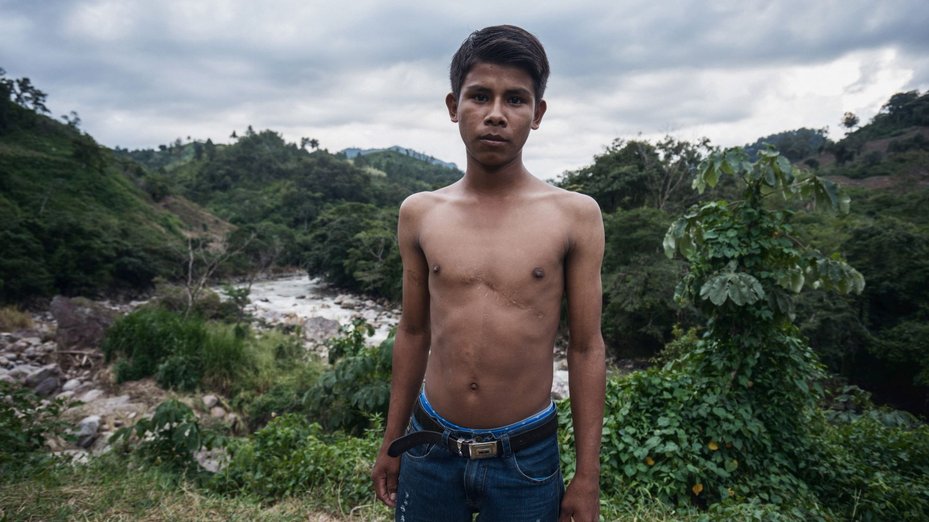
Alan García from Rio Blanco, Honduras. A flawed election has ushered in even greater repression of civil society in Honduras, one of the deadliest countries per capita for defenders. Giles Clarke / Global Witness
Corruption is at the root of much of the violence perpetrated against land and environmental defenders.
When people have a vested interest in making sure a project goes ahead, they tend not to show many scruples in making sure it does – as shown by the case of the Agua Zarca dam in Honduras. The dam, owned by Desarrollo Energetico SA (DESA), sits on the Gualcarque River, considered sacred by the indigenous Lenca people of western Honduras.
Berta Caceres, an Indigenous leader, fiercely opposed the dam and received death threats for years. Then, in March 2016, Berta was brutally murdered.
The dam’s owners used legal action to intimidate those demanding a proper investigation into her killing. For example, on 28 February 2017, Suyapa Martinez, a women’s rights defender, was summoned to court, accused of divulging inaccurate and detrimental information about DESA. The case was later dropped by the court.
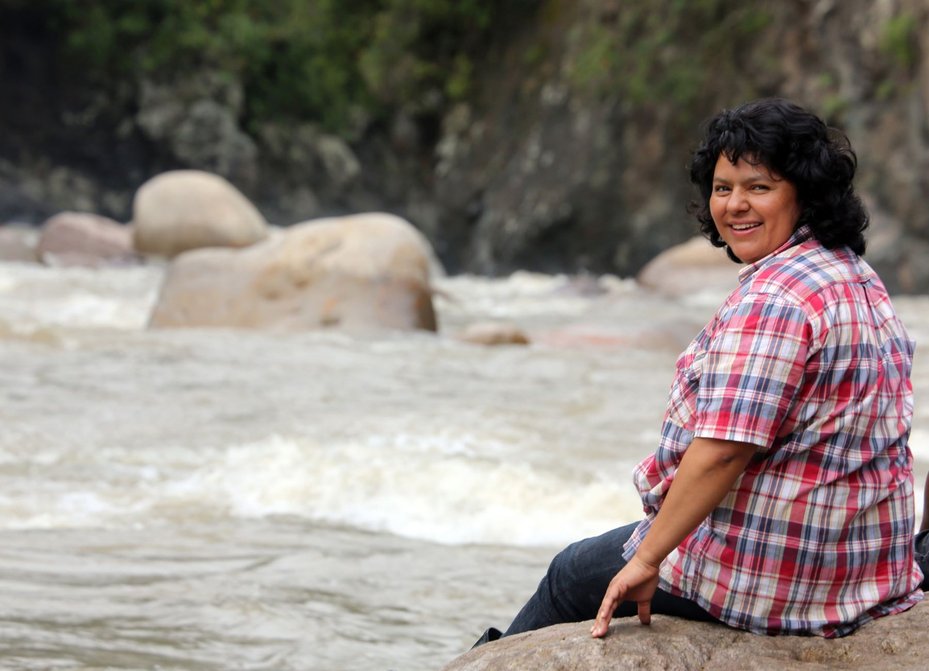
Despite the international outcry that followed the murder of Berta Cáceres, the Honduras government continues to fail in its duty to protect land and environmental defenders.Goldman Prize
Negligence or deliberate omission?
It took an independent group of international lawyers, GAIPE, to eventually shed light on who was responsible for Berta’s killing.
GAIPE’s investigation concluded there was irrefutable proof that high-ranking DESA executives and employees, along with state agents, were involved in the planning, execution and cover-up of Berta’s murder.
DESA’s executive director, David Castillo, was accused of masterminding her death and, since the report’s publication, has been arrested – a welcome development in an otherwise bleak panorama.
The investigation also exposed, at best, a shocking level of negligence or, at worst, deliberate omissions by the state’s official investigators.
GAIPE examined 40,000 pages of evidence that had been in the possession of the Honduran prosecutors for at least 18 months – crucial information that could have been used to investigate Castillo and his accomplices as suspects in Berta’s murder sooner.
There are clear links between the government and DESA that suggest a potential cover-up: the company’s hierarchy contains a number of ex-government officials – for example Castillo himself worked for military intelligence – while four of those on trial for Berta’s murder have links with the military.
The government, together with DESA, even launched legal charges against her organisation, COPINH, and failed to protect its members when they were threatened.
Furthermore, MACCIH – an international anti-corruption panel in Honduras – is investigating suspicious links between members of the ruling party and companies that won bids to construct hydroelectric projects, including the Agua Zarca dam.
MACCIH’s head, Juan Jimenez Mayor, resigned in February 2018 citing persistent government resistance to his investigations.
DESA insist that Agua Zarca is not linked to any act of violence, that the project has always acted in accordance with Honduran law, and that GAIPE’s report is a fabrication containing false interpretations drawn upon selected conversations that have been taken out of context.
Greater repression than ever
Berta’s murder and the search for justice came amid deepening political turmoil and shocking levels of violence against land and environmental defenders.
In our January 2017 report Honduras: The Deadliest Place to Defend the Planet, we revealed that over 120 people were killed between 2010 and 2016 – more than anywhere else per capita during the same period.
We demonstrated how the situation worsened in the context of impunity, corruption and "business at any cost", which characterise President Juan Orlando Hernandez’s regime.
The report sparked a hostile backlash from the authorities in Honduras, who threatened our staff with arrest amid a sophisticated online campaign to discredit our work and that of many other activists.
While the number of murdered land and environmental defenders in Honduras appears to have fallen in 2017, human rights defenders in general are facing increased repression. The National Human Rights Defenders Network of Honduras documented 1,232 attacks against human rights defenders in Honduras in 2016 and 2017, a significant increase on previous years.
Last year’s elections offered the possibility of change – but those hopes were dashed when street protests about alleged electoral fraud left more than 30 people dead. The UN found that at least 16 of them were killed by government security forces.
President Hernandez was declared the winner on 17 December 2017. But the result was disputed by the Organisation of American States (OAS), which called for new elections, stating that the "electoral process was characterised by irregularities and deficiencies … and [was] lacking integrity."
"We will have to kill you"
Threats and attacks against land and environmental defenders remained routine in 2017.
For example, Martin Fernandez, coordinator of MADJ, an organisation that works on land rights and corruption, was assaulted by armed men on 4 August 2017. He’d been inspecting environmental damage caused by a hydroelectric scheme in Northern Honduras.
Another member of MADJ, Luis Mejia, received a note under his door after his house was sprayed with bullets on 12 October 2017. The note read:
We don't want to, but if you don't disappear in three days, we will kill you.
A vocal opponent of illegal logging on his ancestral land, Luis left home in fear of his life.
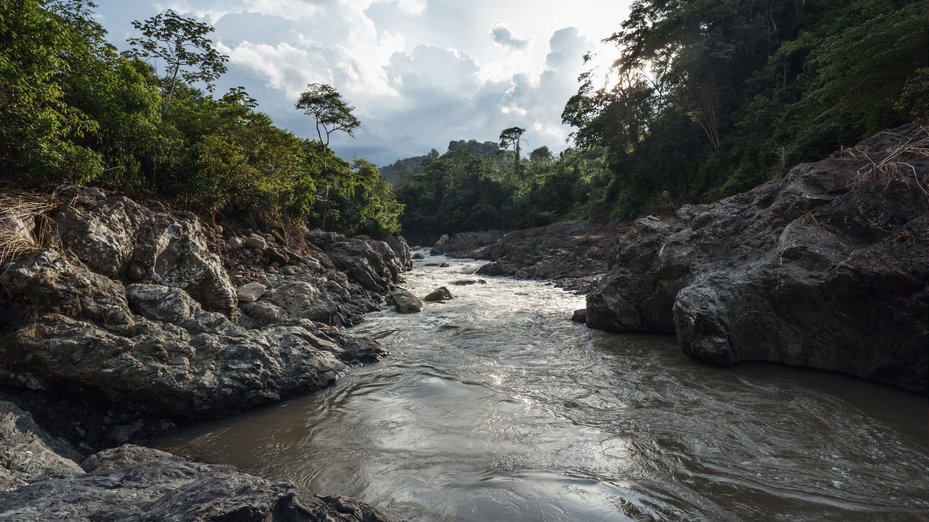
The Gualcarque River, sacred to local indigenous communities and the site of the controversial Agua Zarca dam.. Giles Clarke / Global Witness
By hook or by crook: Corruption and repression in Honduras
- Five land and environmental defenders murdered, down from 14 in 2016.
- However, repression of human rights defenders in general has worsened, with activists facing criminalisation, death threats, police brutality and killings during protests.
- Corruption remains an issue, amid suggestions prosecutors sat on evidence in the emblematic case of Berta Cáceres.
Recommendations to the government of Honduras
- Tackle root causes. Guarantee that the MACCIH (Mission of Support Against Corruption and Impunity in Honduras) operates effectively, independently and that its recommendations are fully implemented.
- Support and protect. Ensure that the Mechanism for the Protection of Human Rights Defenders takes actions to prevent attacks on defenders, and that its protection measures are determined according to a risk analysis which fully assesses the needs of the defender at risk.
- Ensure accountability. Establish an independent international commission to investigate human rights abuses in the context of the 2017 Presidential election and its aftermath.
Colombia
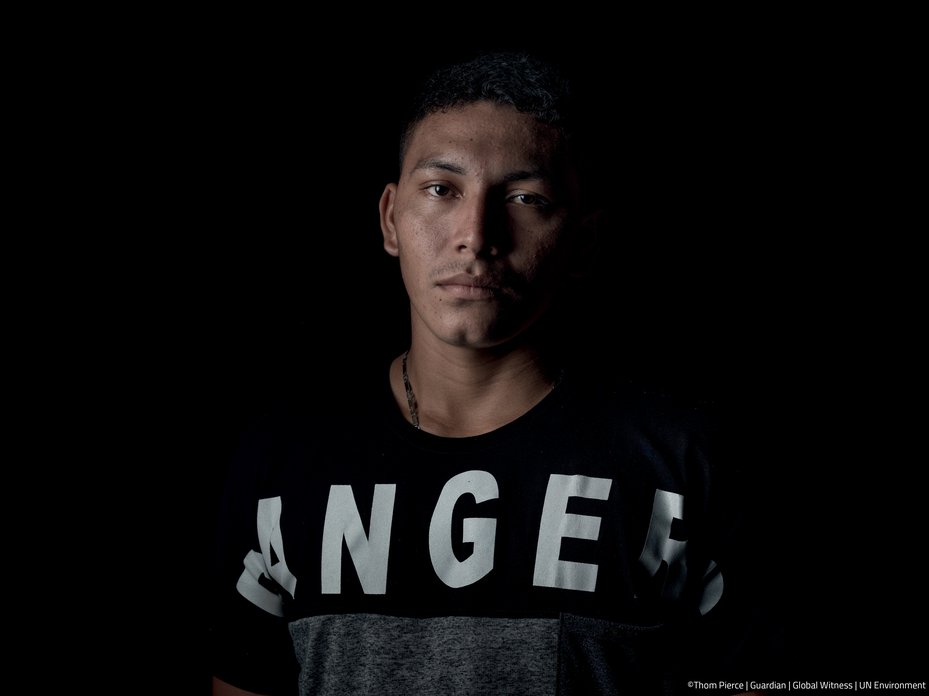
Ramón Bedoya from Riosucio, Colombia. Land conflicts are intensifying in the wake of the Colombian peace process, as returning communities clash with those attempting to grab land for commodities such as palm oil, in a country where impunity rules.Thom Pierce / Guardian / Global Witness / UN Environment
In Colombia impunity rules and history repeats itself. Seven years apart, two brave men from the same region die struggling for the right to remain on their land.
New research by Global Witness and the Vance Center shows the real impact of impunity upon land and environmental defenders.
On 30 July 2010, Jhon Jairo Palacios rang his family from Riosucio, the capital of Chocó department, where he’d travelled by boat from his community, to tell them he would be coming home the following day.
When he failed to show up, they called his mobile. A man claiming to belong to a paramilitary group answered, saying: "Tell his family that he is already dead."
Jhon was a member of an Afro-descendant community in the Cacarica River Basin of Chocó. Community members opposed the construction of a major road in the region – a road that would bring with it deforestation, an influx of settlers and devastation to the community’s way of life.
Tell his family that he is already dead
To this day, Jhon’s murder remains unsolved. The investigation is at a standstill, the murderers are at liberty, and the message being sent is clear: there will be no price paid for murdering defenders here.
Seven years later, on 8 December 2017, Hernán Bedoya – another Afro-descendant leader from Chocó – was heading home on horseback to his village. A new paramilitary group intercepted him on a bridge and shot him 14 times, killing him.
Hernán had objected to the palm oil, banana plantations and cattle ranches expanding over his community’s territory and clearing the forest. He had been forcibly evicted from his land by a paramilitary group in 1996, but decided to return despite the risks.
He began receiving threats from illegal armed groups in 2015. According to local civil society, the Colombian government had given Bedoya a mobile phone and a bulletproof vest in an attempt to protect his life. Nonetheless, Hernán was killed.
Those who wanted to silence him presumed that, like in the case of Jhon, they would face no consequences for their crimes.
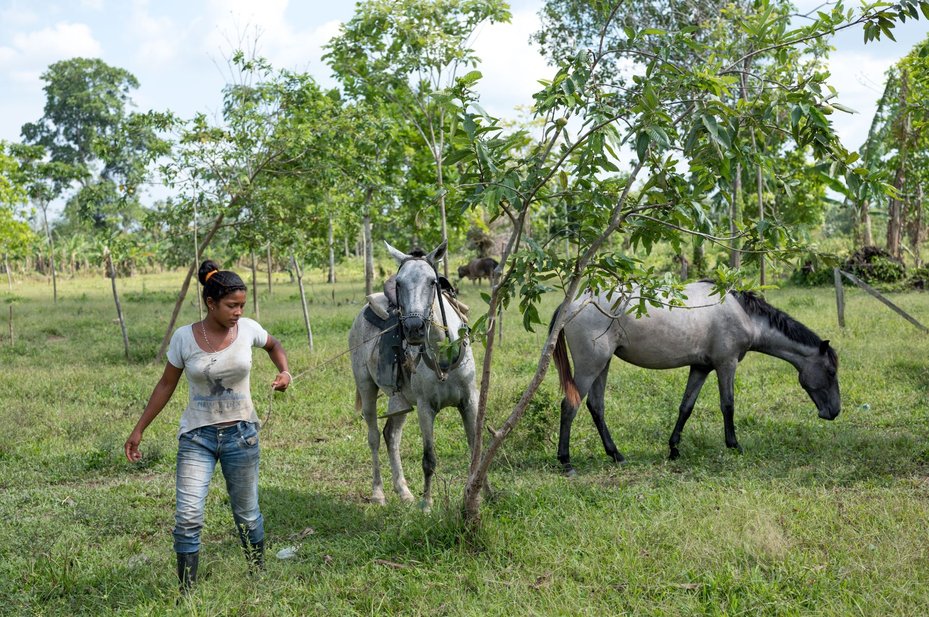
In Colombia a culture of impunity, fuelled by corruption, leaves defenders at risk when investigations into previous attacks fail to advance. Thom Pierce / Guardian / Global Witness / UN Environment
Vacuum of power
Hernán was just one of 24 defenders killed in Colombia in 2017, making it one of the most dangerous countries in the world to defend land and the environment.
There are several reasons for this, though struggles for land lie at their core. According to the United Nations Human Rights Office, the signing of the peace agreement between the government and the guerrilla group FARC produced a "vacuum of power".
With the FARC demobilising, new militias have sprung up, vying with paramilitary groups to control land which belongs to the Indigenous, Afro-Colombian and other rural communities who had to vacate it during the civil war and are now returning home following the signing of the peace agreement.
This scenario is complicated further as criminal groups move into areas the FARC once occupied to carry out illegal logging, mining and cattle ranching. The government’s push for foreign investment has also intensified this scramble for land.
These factors have led to intensifying land conflicts and environmental destruction. Communities have been forced to activism, becoming defenders on the front line of this struggle.
The danger is exacerbated by the fact that governmental protection programmes remain limited in their effectiveness and – vitally – that perpetrators of previous attacks on defenders are rarely prosecuted.
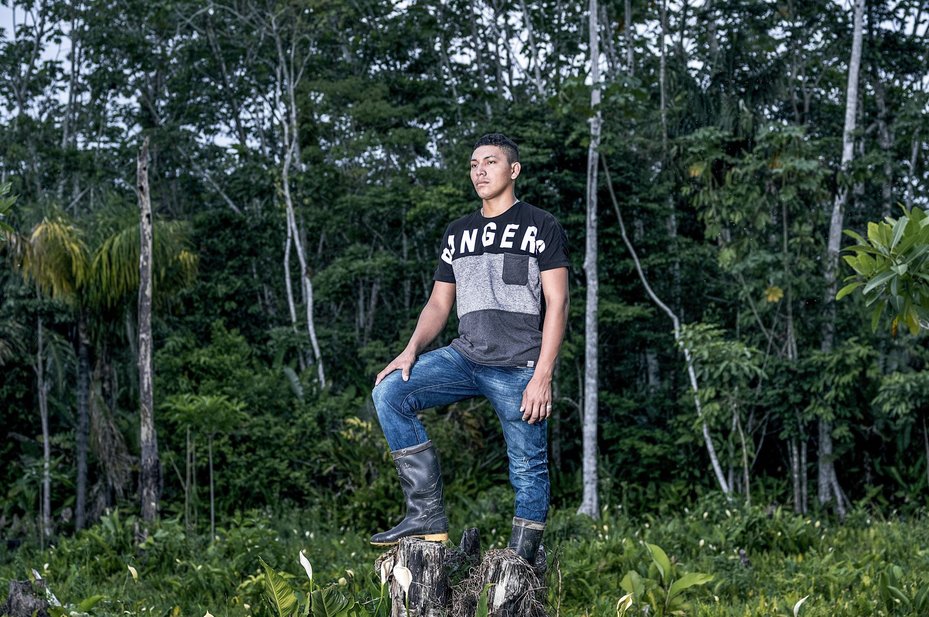
Ramón Bedoya's father was murdered after trying to protect a biodiversity zone from banana and palm oil plantations. Now Ramón has taken on the fight. Thom Pierce / Guardian / Global Witness / UN Environment
Killing with impunity
Perhaps the most crucial factor behind Colombia’s appalling death rate is its persistent and unaddressed culture of impunity. The murders of Jhon and Hernán are just two of numerous unsolved murders in Colombia. So long as previous crimes against defenders go unpunished, those wishing to silence activists will feel emboldened to act.
To try to understand the scale of the problem, Global Witness joined forces with the Vance Center. Together, we analysed the killings of all 122 Colombian land and environmental defenders recorded by Global Witness between July 2010 and June 2016, and the Colombian judiciary’s response to each.
The conclusions of the study were astonishing: in 102 cases, an investigation was launched, but only nine cases led to a verdict, eight of which resulted in a conviction. A further ten cases were not being investigated because the prosecutor’s office had no information at all to go on.
This puts the impunity rate – the proportion of people literally getting away with murder – at 92%.
Crucially, 61 of the 102 investigations were still at an inquest stage, meaning that the prosecutors had not gathered enough information even to determine the existence of a crime. This meant that the investigation could not proceed to the next phase.
It suggests that the public prosecutors’ failure to collect the evidence they need at this early stage is a key factor in the sky-high impunity levels, a conclusion also drawn by Colombian NGO Somos Defensores.
To end Colombia’s culture of impunity, their study concluded, prosecutors must be given the training and resources they need to investigate cases and, perhaps more importantly, the endemic corruption which prevents the killings of defenders from being investigated must be tackled.
The government recently pledged to tackle impunity for killings of defenders, stating they had set up an elite police task force and investigation unit to dismantle criminal groups and investigate attacks against activists. Proper resourcing and guarantees of independence are required if it is to do its job and prevent future attacks.
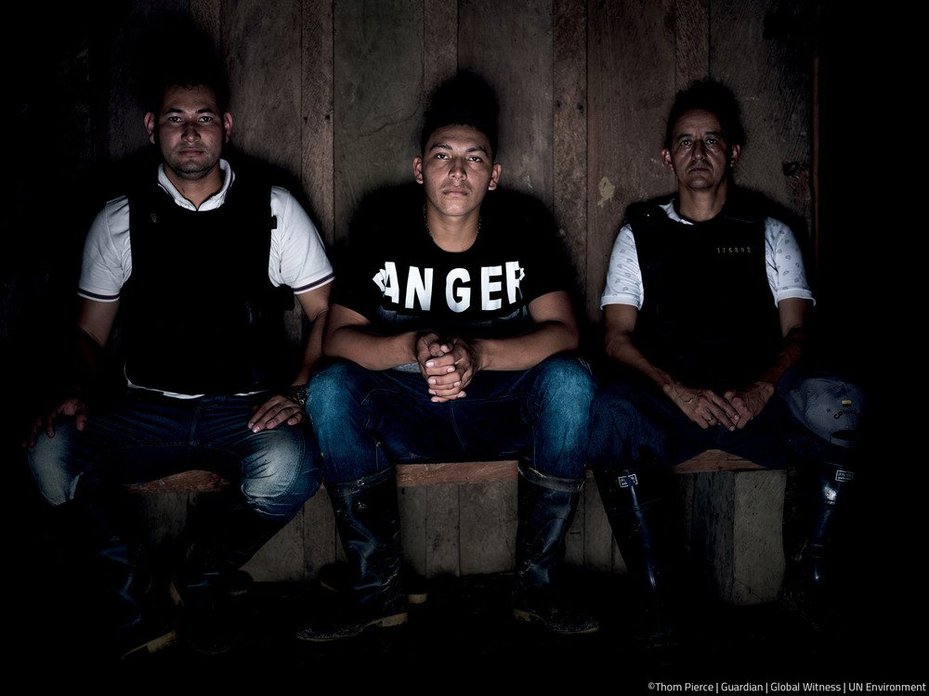
Ramón Bedoya has two bodyguards detailed to him by the government after his father was murdered by a motorcycle gunman. Thom Pierce / Guardian / Global Witness / UN Environment
Getting away with murder: Impunity in Colombia
- 24 defenders murdered in 2017 – Colombia among the three worst countries every year.
- New research by Global Witness and the Cyrus R Vance Center for International Justice (Vance Center) shows how impunity is still fuelling the violence: perpetrators for past attacks on defenders roam free, as the majority of cases fail to advance beyond inquest stage.
- The situation has worsened since the peace process: displaced community members are attacked when returning home, while rival actors vie to fill the power vacuum and control natural resources.
Recommendations to the government of Colombia
- Tackle root causes. Prioritise and guarantee implementation, across all departments of the country, of land restitution processes and related clauses of the peace agreement.
- Support and protect. Guarantee the implementation of appropriate protection measures for defenders at risk, including by guaranteeing defender participation in their risk analysis, by providing collective and not only individual protective measures, and by differentiating measures according to the specific profile, context and threat faced.
- Ensure accountability. Sufficiently resource the independent task force and investigation unit for attacks against activists.
Africa
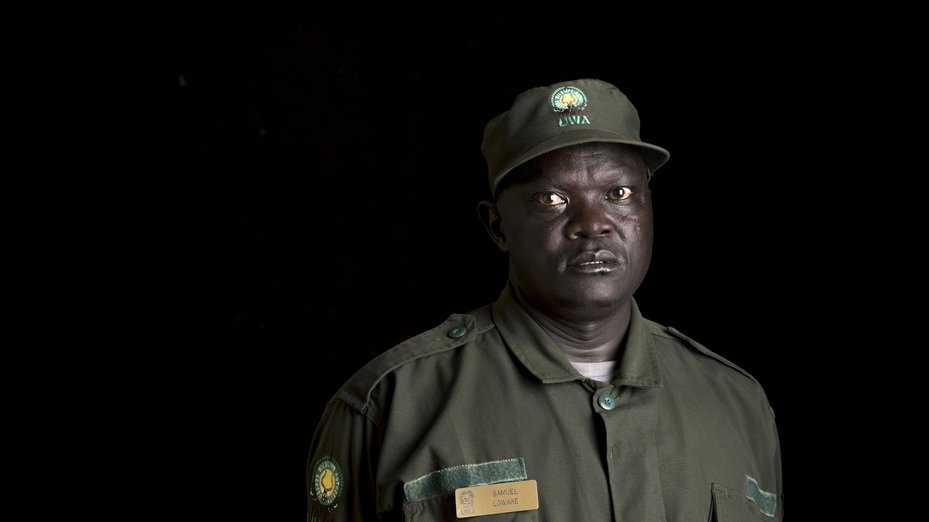
Samuel Loware from Kidepo, Uganda. Rangers are risking their lives protecting wildlife on the African continent where the true scale of violence against defenders remains unknown. Thom Pierce / Guardian / Global Witness / UN Environment
The full picture?
Many African countries suffer from high levels of violence, corruption and impunity.
Conflicts over land and natural resources are frequent and well documented. The brutal harassment and criminalisation of activists is all too common as well.
That is what makes our figures for Africa confusing. We report that 19 land and environmental defenders were killed in Africa in 2017, significantly fewer than in Latin America and Asia. Front Line Defenders, who track the killings of all human rights defenders, also recorded small numbers of cases across Africa in 2017.
What explains the relatively low number of killings? This deserves more analysis, as several hypotheses exist. Are land and environmental defenders really less active and therefore not as targeted in African countries as they are elsewhere? Are the patterns of harassment different, meaning that they rarely end in murder?
Perhaps simply a lack of reporting is underestimating the true extent of the problem.
We do not yet know the answers to these questions, but there are signs that point towards a shortage of evidence leading to some killings of defenders in Africa being undocumented.
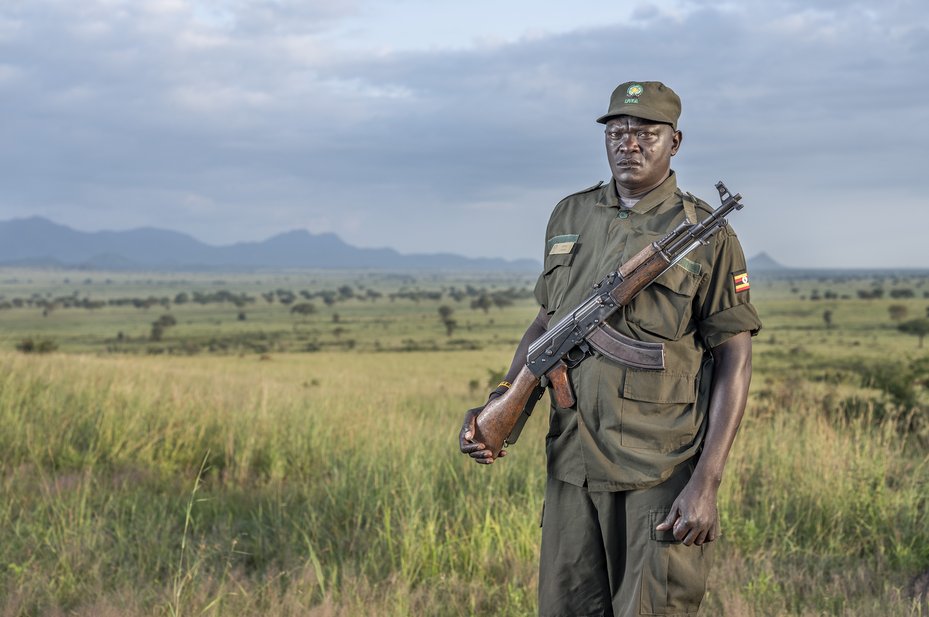
Many park rangers regularly put themselves in danger to protect wildlife from poachers.Thom Pierce / Guardian / Global Witness / UN Environment
A shortage of evidence
Compared with Latin America and south-east Asia, there are fewer civil society organisations and journalists documenting attacks against land and environmental defenders specifically, and they may feel less free to speak out without fear of reprisals.
There may also be less information and reporting from isolated rural areas where killings may take place, compared to other regions.
It is therefore difficult to obtain evidence from many African countries. Less local documentation means we do not have as strong a network of contacts in Africa as we do elsewhere, and much of our information comes from the International Ranger Federation and its charitable arm, the Thin Green Line Foundation, which support one subgroup of land and environmental defenders: park rangers.
Seventeen out of the 19 killings we documented in 2017 were of people struggling against poaching and for the protection of wildlife – usually in protected areas – so our sources may well influence our statistics.
It can be difficult to disentangle the different reasons why someone was killed: we may know that a defender was murdered, but not have sufficient evidence to show it was because of their work as a defender.
To include cases of killings we need a certain level of information to fulfil our verification criteria (see Methodology on page 52 of full report), which is often lacking in the African context.
For example, we need the names of those killed – something that proved impossible when trying to verify who was murdered during 2015 protests against plans to clear forests in central Ethiopia.
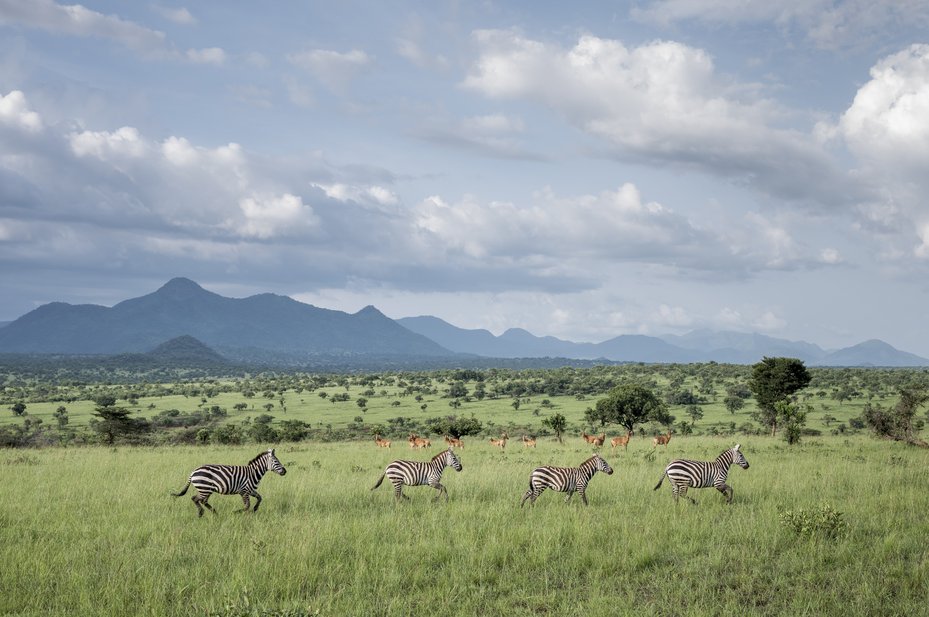
Kidepo National Park in Northern Uganda, a regular target for poachers looking for Ivory, buffalo meat and ostrich feathers.Thom Pierce / Guardian / Global Witness / UN Environment
Conservation-related killings
One relatively well-reported issue in Africa is its significant, long-standing problem with wildlife crime – one of the largest and most profitable forms of organised crime worldwide. Wildlife trafficking helps to finance militia and terrorist groups and is carried out by the same people, using the same illegal networks that traffic drugs, guns and people.
As mentioned above, 17 out of the 19 killings we’ve documented in Africa are of individuals who were defending protected areas. In the Democratic Republic of Congo (DRC), 12 park rangers were killed while protecting wildlife.
All but two killings were attributed to Mai Mai (local armed groups), who are known to be involved in illegal poaching and mining activities. Virunga National Park, where five park rangers were killed, has traditionally been considered the most dangerous place for park rangers in the world.
According to the head of the park, Emmanuel de Merode, there are around 1,500 to 2,000 armed fighters from different rebel groups operating in the area, and they represent a risk for the wildlife and those who defend it.
While we have not been able to attribute wildlife trafficking to attacks against land and environmental defenders we do know that two key conservationists, who’ve dedicated their lives to combatting the ivory trade, were killed over the past 12 months in suspicious circumstances.
While the motives for these killings are still not clear, their murders warrant further scrutiny from law-enforcement agencies.
Women
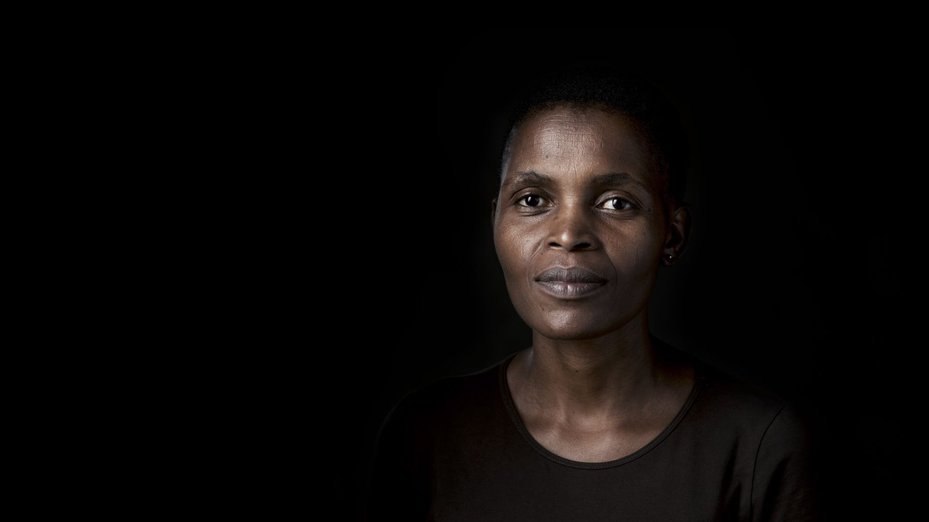
Nonhle Mbuthuma from Xolobeni, South Africa. Women and girls are defending their land, life and equality in the face of gender-specific violence and threats.. Thom Pierce / Guardian / Global Witness / UN Environment
Defending land, life and equality
While the majority of defenders killed in 2017 were men, women defenders are at the forefront of many struggles for land and the environment around the world. They suffer distinct – and sometimes heightened – risks.
We asked Just Associates (JASS) to write the following piece, which is informed by feedback from hundreds of women human rights defenders in more than 26 countries around the world, many of whom are fighting for land and environmental rights.
It also incorporates learnings from protection networks like the Mesoamerican Women Human Rights Defenders Initiative, and other feminist organisations such as the Association for Women’s Rights in Development (AWID) and the Urgent Action Fund (UAF).
Women are often at the forefront of struggles to protect their ancestral lands and the environment. This frequently puts them on a collision course with industries that devastate natural resources in the name of "development". The critical leadership role they play comes at a high price that is often invisible.
There are those who continue to believe that a woman’s place is in the kitchen ... this is used as a reason to exclude women from talks regarding resources
Many women are at a distinct disadvantage at the outset of their land or environmental activism. They are frequently excluded from land ownership, as well as community negotiations about the future of their lands and natural resources.
When they dedicate time to activism, they are sometimes criticised for neglecting their children and domestic duties. On the other hand, the combined impact of domestic and community care, together with activism, can create a huge physical and emotional burden.
Women defenders often have to fight a battle on two fronts: the public struggle to protect natural resources, and the hidden struggle to defend their right to speak out within their own organisations and families.
Women defenders rarely receive the same level of support as their male colleagues because their communities are often dominated by patriarchal, macho culture. This means that the role that women defenders play is often not recognised, and their communities, organisations and families sometimes even actively hide the violence which women can face.
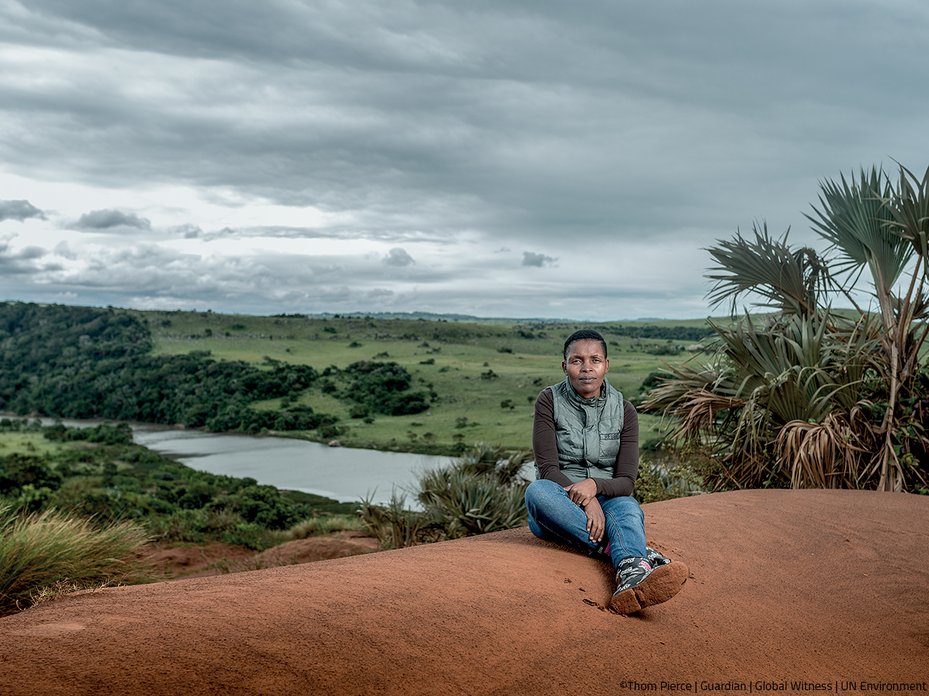
Nonhle Mbuthuma is the chairperson of the Amadiba Crisis Committee, an organisation that for years has been fighting titanium mining in Xolobeni, South Africa.Thom Pierce / Guardian / Global Witness / UN Environment
The gendered nature of violence
Although more male land and environmental defenders are murdered, women can feel the impact distinctly. When male defenders are killed or imprisoned for their activism, women shoulder more family responsibilities, often while pursuing justice for the murder and helping to re-organise their communities.
Women defenders themselves are targets of multiple forms of violence, both for defending their territory and for challenging patriarchal attitudes in their communities, organisations and families.
A range of state and non-state actors with powerful economic and political interests have historically used violence against women to spread fear and silence the pursuit of justice.
They [military and police forces] use violence and sexual violence to intimidate local women and girls and repress resistance. In some cases, soldiers or police gang-rape women as a form of punishment, [for example] for “trespassing” on diamond fields that were once their ancestral lands
Threats of rape and violence historically form part of the repression of women opposing extractive projects, as well as misogynistic insults such as being labelled "whores" or "bad mothers". Gender discrimination is one of many fault-lines exploited to exacerbate family or community conflicts through divide-and-conquer tactics.
Two pregnant land defenders – Andrea and Maria Miradel – were jailed for allegedly “participating in criminal activities”. Both women were denied immediate medical attention, leading to the death of Andrea’s two-day-old daughter
Criminalisation, too, has a distinct impact. It increases the financial and social vulnerability of women, as their families often isolate them if they are jailed. Of course, women defenders are also murdered.
This is not only about silencing defenders; it’s about silencing women and sends a strong message that women should not be leaders, thus inhibiting others from getting involved.
The power of women is a collective power that fosters community; that’s what strikes fear into the supporters of extractive policies...we need to declare our territories free from violence, free from mining; we want to be able to celebrate the water, land and air as vital and brimming with life, not as commodities for sale
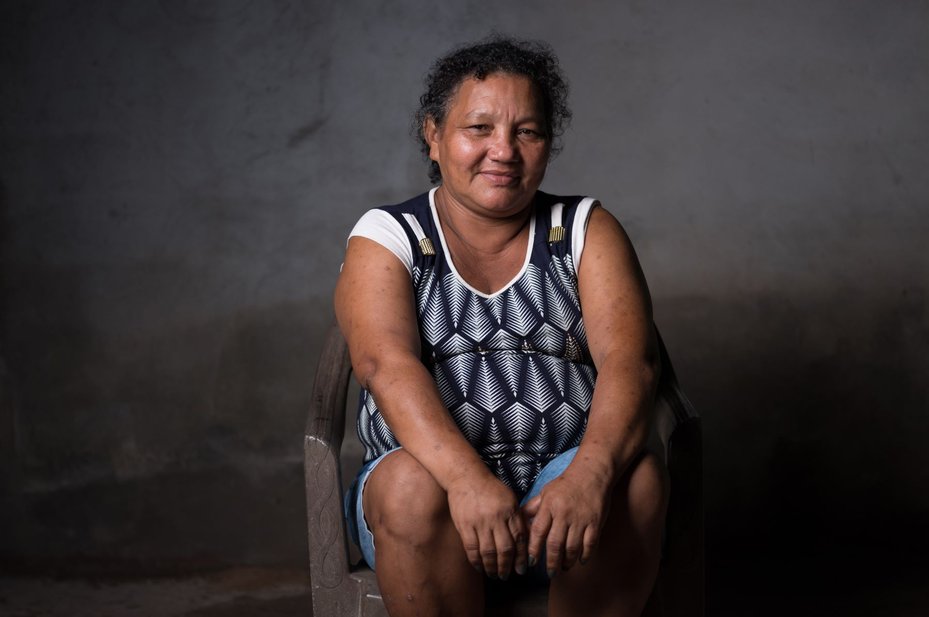
Women defenders are a powerful force for communities campaigning against extractive projects, often shouldering the weight of family expectations and community leadership, in the face of gender-specific threats.. Thom Pierce / Guardian / Global Witness / UN Environment
What businesses and governments can do for defenders
States and business can and should prevent threats against defenders.
Land and environmental defenders are on the frontline of the fight to save our planet from climate change, safeguard human rights and protect vulnerable communities from harm.
They champion causes that benefit us all: sustainability, biodiversity and justice.
They call out corruption and push for changes in laws, policies and practice to ensure environmental and land rights are upheld.
Yet few people face greater threats. Once again, as part of an ongoing trend, the number of defenders murdered rose in 2017.
Two hundred and seven activists were killed, leaving communities without their courageous spokespeople and champions.
It is primarily the responsibility of states (through their governments) to guarantee that all human rights defenders can carry out their activism safely.
However, those defenders who work on land and environmental issues face specific and heightened risks because they are seen as a threat to profit as well as power.
In the vast majority of cases, they are killed because they have questioned or opposed a business enterprise – one usually linked to the extraction of natural resources, such as mining, large-scale agriculture or logging.
With much of the violence driven by the thirst for profit, those who hold the purse strings have the power – as well as the legal responsibility - to be a force for good.
Who is responsible?
A range of actors influence business projects. These same actors can ensure that land and environmental defenders are able to carry out their work without fear of being attacked or killed:
State actors
- Governments of the countries where defenders are at risk. Politicians, state officials and security forces – at the national and local level – should all take action to protect the rights of defenders.
- Bilateral aid and trade partners – politicians and officials of countries doing business in, or providing aid to, places where defenders are at risk.
Business actors
- Companies – Whether big or small, and whether operating where defenders are at risk or buying commodities and products from those who are, companies can play an important role in supporting defenders and respecting their rights.
- Investors providing finance for companies and projects. They include private banks, development banks, pension funds and private equity, among others. Development banks are somewhat of an anomaly. They have the leverage of an investor, but – given that their shareholders are states – the duty of a government. In our 2017 report Defenders of the Earth, Global Witness explored the role of development banks in protecting defenders.
What should be done?
In Defenders of the Earth, Global Witness published a range of general recommendations, which can be interpreted and implemented by the state and business actors outlined above.
In 2017, steps were made by some actors to implement these recommendations which are formulated along three lines:
- Tackle root causes: The only effective prevention in the long term. This means combating corruption, securing land titles, respecting collective and customary land rights, and guaranteeing the right of affected communities to give or withhold their free, prior and informed consent regarding the use of their land and natural resources.
- Support and protect: Business and states can take a range of measures to recognise the role of defenders, advocate for their protection, provide them with the tools they need to carry out their activism effectively, and guarantee their safety.
- Ensure accountability: To prevent future threats, those responsible for attacks on defenders must be brought to justice, while those who fail to support and protect them should face political, financial and judicial consequences. Ensuring accountability is a fundamental step in dissuading future attacks, tackling one of their principal root causes: impunity.
A legal duty towards defenders
At the heart of the problem lies an irresponsible approach to business. On too many occasions, the quest for profit drives business decisions, fuels corruption and divides communities, sparks conflicts and damages the environment.
Land and environmental defenders have expertise, experience and an understanding of their local context which could help solve these problems.
If activists are to carry out their work in safety and be champions of the environment and their communities, then states and businesses must comply with their legal duty to protect and respect these activists’ rights. As we will see later, it is also in their interest to do so.
The state duty under international law and guidance
The legal obligation to protect human rights lies primarily with the state.
The UN Guiding Principles articulate how existing international law should be applied in the sphere of business and human rights. They are the global standard for preventing and addressing the risk of adverse human rights impacts linked to business, establishing an internationally accepted framework for enhancing standards and practice.
The Guiding Principles are built upon three pillars: the state duty to protect human rights, the corporate responsibility to respect human rights, and access to remedy for victims of business-related abuses.
Principle One says that, within their territory or jurisdiction, states must protect people against human rights abuses by third parties, including business enterprises. Therefore, if a business infringes on the rights of defenders, the government has a legal obligation to stop it.
States should also be guided by the UN Declaration on Human Rights Defenders. It sets out how existing human rights law should be applied to support and protect human rights defenders, of which land and environmental defenders are a subset.
The Declaration highlights the rights that states must protect if defenders are to be able to carry out their activism safely, for example the right to freedom of expression and the right to life.
The UN special rapporteur on human rights defenders has expanded upon the Declaration, outlining nine conditions – including the need for conducive legal frameworks and effective protection policies – that states must put in place for defenders to operate in a ‘safe and enabling environment’.
The risks facing land and environmental defenders often stem from a lack of opportunity for communities to give or withhold their consent.
States can prevent the escalation of conflict which may result in attacks, by implementing existing international conventions that safeguard the right of communities to participate in and give their free, prior and informed consent on decisions that affect, among other things, their land and environment.
These conventions include the International Labour Organization Convention 169, Article 25 of the International Covenant on Civil and Political Rights and the UN Declaration on the Rights of Indigenous Peoples.
There is also a growing body of jurisprudence laying out the extraterritorial duty of governments to protect the rights of citizens in other countries where their businesses are active. This means that it is not only the governments of those countries where defenders face greatest risks who have a duty to protect activists, but also bilateral aid and trade partners operating in those countries.
Government policies on business and human rights must, therefore, drive positive actions to support defenders at home, but also abroad.
Embassies, therefore, have a huge role to play. The EU, Canada, Norway, Switzerland, the UK and the embassies should support at-risk human rights defenders, which could be applied by other states too.
In September 2016, the International Criminal Court widened its remit so that politicians and other individuals, including business people, can now be held criminally responsible under international law for crimes linked to the land-grabbing and environmental destruction which defenders risk their lives to oppose.
The business duty under international law and guidance
The UN Guiding Principles establish that ‘business enterprises should respect human rights’. They go on to explain: ‘Because business enterprises can have an impact on virtually the entire spectrum of internationally recognized human rights, their responsibility to respect applies to all such rights.’
This, therefore, includes respecting all rights that apply to land and environmental defenders, as laid out in the UN Declaration on Human Rights Defenders.
This means that business must respect the rights of defenders and communities to express their views on and protest against business activities.
It means refraining from harming defenders, restricting their rights or interfering with their activities, and it extends to consulting and engaging with defenders to identify, mitigate and remedy any adverse human rights impacts of business operations.
The Guiding Principles oblige business to respect human rights regardless of the state’s willingness or ability to protect them. This means that companies operating in countries with a weak rule of law or high levels of corruption are responsible for upholding the highest standards of human rights.
If they cannot guarantee that affected communities can participate in decisions relating to their business, or are unable to mitigate any risks to defenders stemming from their project, then they should not do business there.
Using deference to local laws as an excuse for failing to protect the rights of communities and defenders is unacceptable, because those laws may lack sufficient protections within them. Companies and investors must guarantee that private security firms, contractors, subsidiaries or anybody along their supply chain are not impeding the rights of defenders and local communities, but are rather properly engaging them, as recommended by the Guiding Principles.
As such, it is not just companies with projects in places where defenders are at risk who should change their practices. Investors financing those companies and other businesses buying from them have responsibilities too.
For example, a bank should never back a project unless it is certain that it will not undermine or restrict the rights of local people. Meanwhile, no company should use timber in its furniture or palm oil in its foodstuffs until it is convinced that rights of affected communities are being protected along the supply chain.
The OECD Guidelines for Multinational Enterprises set out a practical due diligence framework for business across all sectors. They recognise that businesses can cause or contribute to adverse human rights impacts through both actions and omissions, and therefore have a duty to prevent, cease and mitigate such impacts.
This would include those affecting defenders. The Guidelines emphasise a range of actions which businesses can take to leverage change in the practices of any entity involved in their projects, including business partners, entities in its supply chain, and ‘any other non-State or State entity directly linked to business operations, products or services’.
Another OECD document – Responsible Business Conduct for Institutional Investors: Key considerations for Due Diligence under the OECD Guidelines for Multinational Enterprises – outlines how investors should implement the guidelines.
It makes clear that investors, "even those with minority shareholdings," have a responsibility to consider risks "throughout their investment process" and to use their leverage with companies they invest in "to influence those investee companies to prevent or mitigate adverse impacts," which would include threats against defenders.
The business case for supporting, not attacking, defenders
Not only do companies and investors have a legal duty to respect rights and support defenders, it is also good for business.
Affected communities’ and defenders’ local expertise is essential to helping business identify, prevent and mitigate human rights abuses, which in turn serves to minimise legal, reputational, operational and regulatory risks.
Their local knowledge can help business navigate laws and understand local contexts, establish risk management procedures, and design effective grievance policies, mitigation strategies and remediation mechanisms, building strong foundations for a project’s long-term security and effectiveness.
By engaging defenders and local communities, business is better prepared to prevent and mitigate negative human rights impacts and build relationships with local stakeholders.
This approach can minimise the risk of community conflict and social strife, which can lead to interrupted production, security costs, crisis management, litigation and reputational damage. In other words, projects are more likely to be successful and sustainable.
Evidence shows that failure by companies to avoid conflicts over land can significantly increase their financial risk, increasing the project cost or even in some cases endangering the future of the company.
The Rights and Resources Initiative, for example, found that a typical investment encountering land tenure problems can increase the cost of projects by up to 29 times.
Ethical business and the management of environmental, social and governance risks are often rewarded by both consumers and markets. What is more, a context in which defenders are safe is a context conducive to business stability and success too.
Both benefit from transparency, rule of law and civic freedoms. What is good for defenders is ultimately good for business.
What should business do?
In 2015, a cross-regional group of 39 human rights organisations outlined the following principles for how business might play a proactive positive role to engage and support human rights defenders.
These principles should be incorporated into any corporate policy on human rights and environmental defenders. See here for details of how these principles can be put into practice.
- Respect and engage defenders
- Support and partner defenders
- Advocate and seek remedy for defenders at risk, and stand against laws and policies restricting them
- Make additional efforts and take specific action to engage and protect women defenders and other groups facing particular risks
Agribusiness: The deadly face of irresponsible business in 2017
In 2017, no industry was deadlier than agribusiness. Almost a quarter of the land and environmental defenders murdered in 2017 were protesting against agricultural projects.
This is an increase of 100% from the previous year and provides a chilling illustration of the implications of irresponsible business.
To stop the killings, governments must regulate agribusiness to ensure that companies involved act in accordance with international law, and that those which breach it are prosecuted.
For their part, consumers can demand guarantees that the products they buy are not associated with attacks on defenders.
But champions in the agribusiness industry itself, and among those that underwrite and facilitate its activities, are needed as a matter of urgency.
Companies that implement, invest in, insure or use products cultivated through agribusiness projects must make sure the rights of communities and defenders are protected, including by implementing our recommendations.
The sector would also do well to prioritise implementation of its own voluntary guidelines (see Voluntary guidelines for agribusiness, and their relevance to defenders), in particular:
- Guaranteeing proper consultation and participation of affected communities, and the right to free, prior informed consent
- Ensuring transparency in all areas of business, and a zero tolerance policy on corruption
- Ensuring proper due diligence along supply chains
- Ensuring that these guidelines are properly implemented at every moment of the project cycle
- Ensuring proper grievance mechanisms and access to remedy
Since publication of this report new information has come to light which has meant the killing of six Indigenous farmers in Peru in September 2017 no longer fits our criteria for inclusion. As such, the figures for 2017 have been revised to 201 killings globally with 40 linked to agribusiness and two occurring in Peru over the year. Please contact us at [email protected] if you have any further enquiries on this or the methodology involved.
